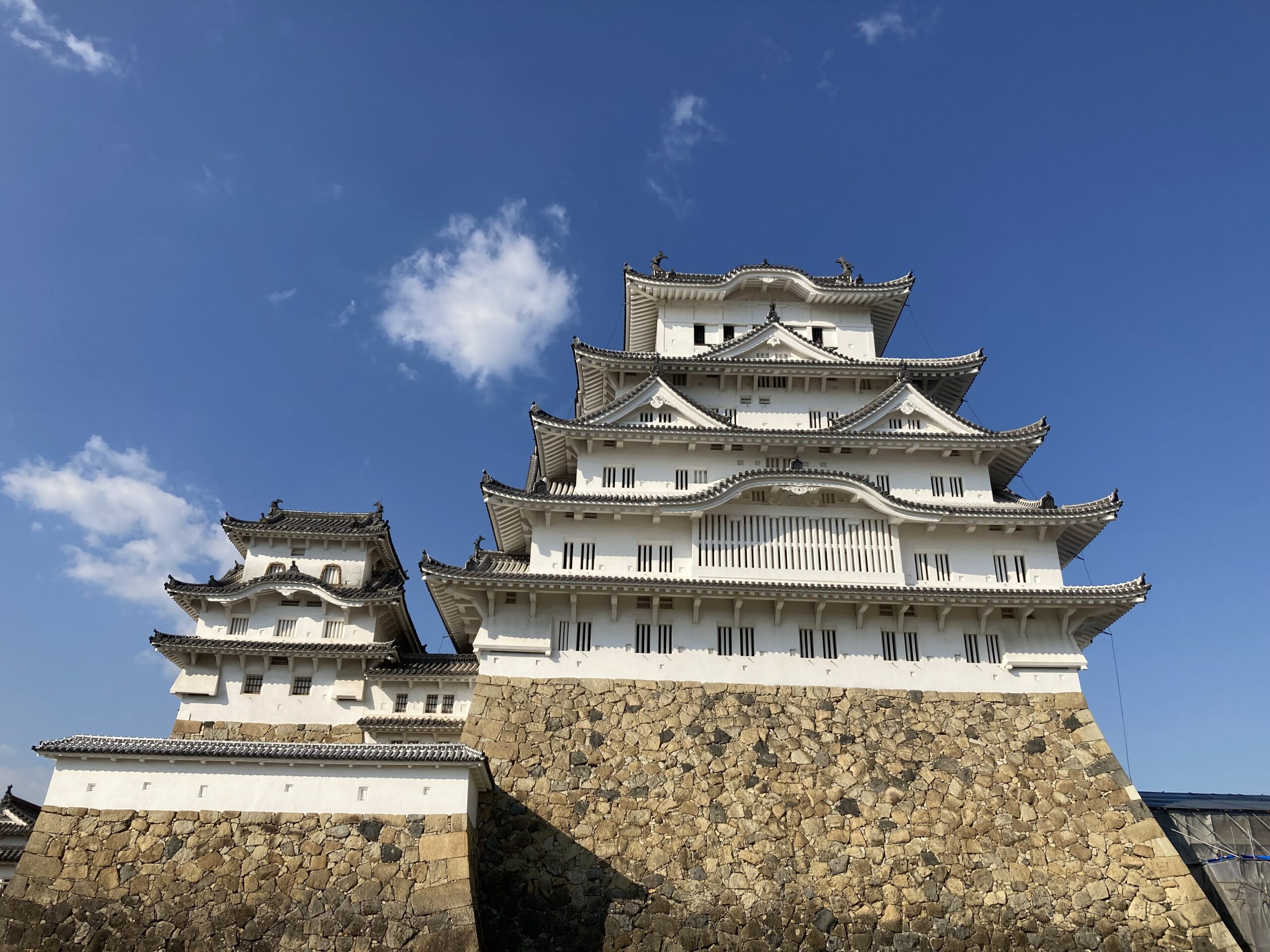本ブログは観光業、企業接待、留学生対応等で英語案内が必要ながら、多忙で準備に時間をかけられない方々の為にすぐに使える情報を分かりやすく解説しています。
今回は一緒に電車で移動中の重要顧客(訪日外国人)から、少し時間があるので最寄り駅で降りて「お城」を見学したいと突然言われた場合の『日本の城』に係る英語表現についてご紹介します。
👉注1)冒頭の『天守閣』、『堀』、『腑に落ちる』の英語表現は夫々リンク先でご参照頂けます。
👉注2)本ブログでは、実際にお城を目の前で観ているインバウンドの視点(関心処)を踏まえ、雑踏の城内をブラブラ歩きながら口頭でご理解いただけるシンプル(直感的)な表現を目指しておりますので、高度で専門的な表現をお望みの方は各現地の公式サイトやカタログをご参照下さい。多言語で詳細な情報と表現が入手できます。
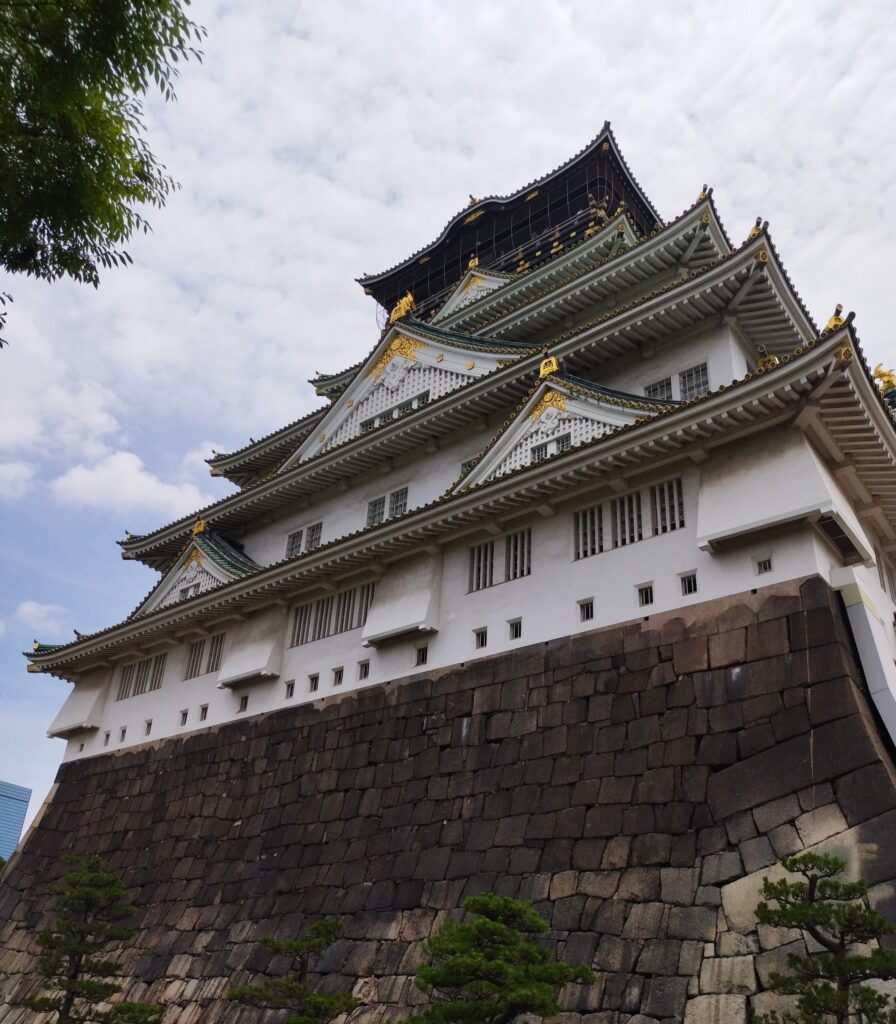
0.事前の心得(ご参考)
本来テーマではありませんが、アウェーでの城案内なので、できれば事前に押さえておきたいポイントをご参考までにご紹介します。その分、後の展開が楽になりますので。不要な方は目次より「1.主要な説明用語」以降の本文にお入りください。
a:予備知識として
これまでの観光データから多くのインバウンドは日本の城について下記に関心があると言われています。根底にあるのは、ご存知の通り、日本人の特徴、生活様式、考え方への興味ですね。我々が海外へ行って、現地の人たちにいだく興味とあまり変わらないと思います。
- 日本の城の歴史(そもそも何から?)
- 日本の城の建築(なんの為にこんなつくりに?)
- 背後にある逸話(何故こうなったの?)
- 日本史におけるお城の位置づけ(皆どう扱ってたの?)
一方、下記のような見方もあるようです。
- 日本の城はどれを見ても皆同じに見える。
- どこが面白いのかよくわからない。
- 固有名詞を言われてもついていけない。興味もない。
b:相手の状況の確認
上記の一般的な傾向を踏まえ、下記についてできるだけ個別確認できると良いですね。
- 目的
- 👉時間潰し、好奇心、情報収集?
- ニーズ・要望
- 👉何がしたい、見たい?
- 好み、嗜好
- 👉散策?花?建築?
- 知識レベル
- 👉日本文化は?歴史は?
- 経験
- 👉お城見学の有無は?程度は?
- 許容時間
- 👉何時間?何時迄?
c:現地の状況
お相手に対する自分の対応範囲(出来ること)を把握するために、下記を押さえましょう。それによって自分の負担もかなり軽減できます。
- 案内所で城の見処と所要時間
- 英文掲示、英文動画の状況
- ボランティア通訳有無と空き具合
- パンフレットとマップ(日英)入手
- トイレ、休憩所、喫煙所の場所
- インドア展示(有料、無償)の有無(特に空模様がよくない時に)
d:確認のための質問例
極力ピント外れの対応を避けるため、もう少し具体的に(勿論無理のない範囲で)聞いてみましょう。もし使えそうな自分の好みのセリフがあれば音声サンプルと一緒にそのまま覚えてしまいましょう。
👄本質問と次にe) インバウンドの視点質問の演習ツールが別ブログ『日本の城』《入城前》英語案内向け《口頭即訳演習ツール(音声サンプル付)》ありますので、必要時には是非ご利用ください。
- これまで日本の城を訪れたことはありましたか?
- これまで日本の城はどこを訪れたことがありますか?
- 日本の城について何かご存知のことございますか?
- 日本の城について何をご存知ですか?
- 日本の城のどんなところに興味がありますか?
- 何故この城に来ようと思われたのですか?
- 地元にお城はございますか?
- ご出身の国のお城はどんな感じですか?
- 西洋のお城を見たご経験はおありですか?
- 城の建築にご興味おありですか?
- 何か具体的にご覧になりたいものありますか?
- ここでのお時間はどれくらいありますか?
- 何時迄戻ってきたいですか?
- 何時迄に戻らなければならないとかありますか?
👉音声サンプルの前半(1~6)は真面目調ですが後半部(6~12)は少しトーンが違います。
- Have you ever visited any Japanese castles before?
- Where did you have a chance to visit?
- Do you know anything about Japanese castles?
- What do you know about Japanese castles?
- What aspects of Japanese castles are you interested in?
- What brought you to this castle?
- Do you have any castles in your local area?
- What are castles like in your home country?
- Have you ever seen Western castles?
- Are you interested in castle architecture?
- Is there anything specific you would like to see?
- How much time do you have here?
- By what time would you like to return?
- Do you have any specific time constraints?
e:インバウンドの視点
個人的バラツキはありますが、多くのインバウンドが(城に入る前)城郭を目の当たりにして感じるであろう素朴な想定疑問例をご紹介します。上述の通り、一般的に彼らは固有名詞(学校で習うような歴史的事件、年号、殿様の名前)より日本人としての生活様式、考え方に興味がありますので、ネットにあるような詳細情報よりも、ご自分のこれまでの(旅行や読書等の)経験や日頃考えていることをわかる範囲でお伝えすることをお勧めします。(下記質問に対する回答例は後の各章で個々に扱いますのでここでは触れていません。)
- そもそも、この城はいつ頃できたか?
- 何故ここに城ができたのか?
- 当時の城がそのまま残っているのか?
- 建て替えたものなのか?復元したものなのか?
- 領主はどんな人達だったか?
- 彼らはどんな生活、日常送っていたのか?
- 日本の他の城と何が違うのか?
- この城はどこが面白いのか?
- 今はどのように使っているのか?
- 建物の維持、管理はどのようにしているのか?
👉音声サンプルの前半(1~5)は気だるい感じの米国女性、方や後半部(6~10)は元気なオーストラリア女性!その違いをお試しください。
- When was this castle originally built?
- Why was this castle built here?
- Is this castle still intact from that time?
- Was it rebuilt or restored?
- What kind of people were the feudal lords?
- How did they live their daily lives?
- What are the differences between this castle and other castles in Japan?
- What makes this castle interesting?
- How is the castle used today?
- How is the maintenance and management of the buildings handled?
1.主要な説明用語
インバウンドへの説明によくつかわれる用語をご紹介します。ご存知の通り、日英の間で一言で対になる用語はなかなかありませんし、一つの単語(例えば「天守閣」でも)色々な英語表現があります。またある英単語で説明しても、それだけではピンとこないこともよくあるので、それを補足する言い換え表現(コメント)もできるだけ知っておくと良いですね。その場合は👉で付記しておきます。また、読みにくい用語には音声サンプル付けました。
1.1 城全般(建物系)
- Japanese castle(城)
- castle town(城下町)
- mountain castle(山城)
- 👉castle built on a mountain
- hill castle(平山城)
- 👉castle built on a hill
- flat-land castle(平城)
- 👉castle built on a plain
- story(《建物の》階)
- 👉a 2-story building(二階建て)
- 👉This tower is 5 stories high(この櫓は5階建て)
- ruined castle / castle ruin(城跡)
- plaster(漆喰、石膏)/ stucco(漆喰)/mortar(モルタル, 漆喰)
- constructed of wood / built of wood(木造の)
- castle wall(城壁)
- stone wall(石垣)
- moat(堀)
1.2 城関連(非建物系)
- fief(領国)
- the Warring States Era/the civil war era(戦国時代)
- lord(領主、殿様)/fuedal lord(大名)
- vassal/retainer(家臣)/vassals(家臣団)
- UNESCO’s World Heritage Site(ユネスコ世界文化遺産)
- national treasure(国宝)
1.3 主要スポット
a:天守閣
天守閣には様々な表現がありますので、纏めてご紹介します。
👉天守閣の詳細情報は『3. 天守閣』パートで。
- main keep/castle keep/keep/castle tower/donjon/tower keep
- 👉the biggest guard tower
- main tower(大天守)
- small tower(小天守)
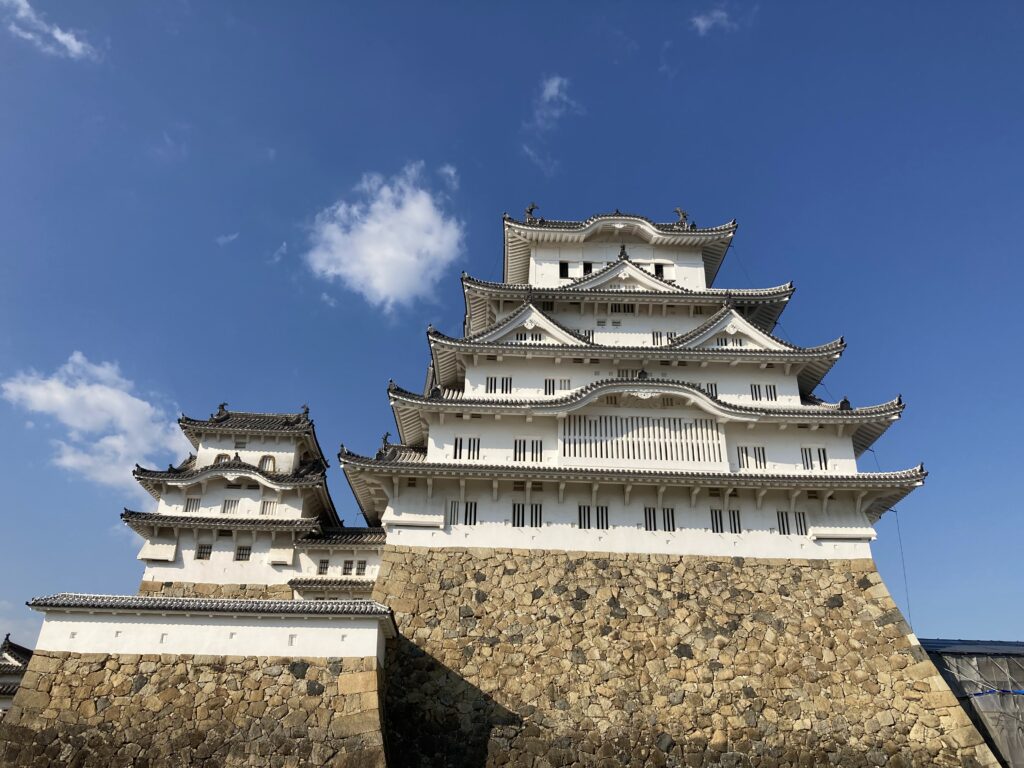
b:曲輪(くるわ)
🔶日本人でもあまり使わない用語ですが、土塁、石垣、水堀で区切られた区画のことで、本丸、二の丸、三の丸も曲輪の1種です。
- enclosure
- 👉area enclosed by earthwork, stone walls, moats
c:本丸
- keep of a castle/main enclosure (of a castle)/center of a castle
- main bailey
d:二の丸/三の丸
- second enclosure/third enclosre
- secondary enclosure/tertiary enclosure
e:堀(ほり)
- moat〈堀/外堀〉
- inner moat/inside moat〈内堀〉
- canal〈掘割〉
- ditch〈溝〉

f:櫓(やぐら)
日本人でも読みにくい用語ですが「矢倉」とも書きます。読んでの通り兵器の倉庫ですが、見張りや装飾などの役目も負っています。
- tower/guard tower/turret
- watchtower(物見やぐら)/lookout tower
- storage rooms (貯蔵庫)
g:城門
西洋の城門には見られない防御形態なので城説明のメインスポットです。詳細は『3.城門』パートで。
- castle gate
- front gate/rear gate(正門/裏門)
- Korai-mon gate(高麗門)《秀吉の朝鮮出兵から導入された開門形式》
- invasion-hindering gate/box shape style gate/rectangular gate(桝形門)
- 👉typical traditional Japanese gate(機能を織り込んだ多様な表現があります)
- 👉gate enclosed by two gates and stonewalls
h:破風(はふ)
日本人の日常会話でもあまり使わない用語ですが、屋根の妻側にできる日本建築独特の三角形の装飾のことです。
- gable《建築用語》
- 👉roof over bay window(出窓の屋根)
- gablet〈小破風〉《建築用語》
i:漆喰(しっくい)
- plaster〈漆喰/石灰/石膏〉
- cement plaster
- lime plaster
- grout
- 👉下記は専門用語《建築用語》です。
- daub《動詞で「塗る」という意味もあります》
- stucco(イタリア語)
2.日本の城(全般)
ここからは各カテゴリーに分けてご説明いたします。まずは「日本の城(全般)」についてです。
2.1 基本情報
説明に役立ちそうなネタ情報です。いつも通り、日本語で言えないことは英語でもダメですので日本語から。👄本パート表現の習得用音声ツールはこちらから。
≪日本語≫
- 日本では古代より支配地域を守るための原始的な防御施設である砦が存在した。
- 現在残る城の多くは約400〜500年前の戦国時代に大きく発展した建造物である。
- 当初は監視や防御のための高台に築かれた山城が主で軍事機能が優先された。
- 戦乱時代の終結にともない、ほとんどの城は政治・経済・文化の中心へと変わった。
- 山城から平山、平地へと立地条件も変わり、石垣、天守閣などの大規模な構造が発展した。
- 最盛期には全国的に300近い城があり、各領主が権威を示すため独自に工夫を凝らした。
- 約260年の江戸時代に、城中心の城下町が発展し、現代の生活スタイルと文化の基盤になった。
- 武士の時代の終焉と共に全国の城は目的を失い多くが取り壊されるか荒廃した。
- 幸運にも取り壊されず維持された12のお城には世界遺産(姫路城)のお城がある。
- 多くのお城は展示品も含め観光用に整備され当時の権力・技術・暮らしが鑑賞できる。
≪英語≫
- Since ancient times, Japan has had primitive fortifications known as forts, built to protect controlled territories.
- Many of the castles that remain today were developed significantly during the Warring States period, approximately 400 to 500 years ago.
- Initially, castles were primarily mountain fortresses built on elevated land for surveillance and defense, with military functionality taking precedence.
- As the era of war came to an end, most castles transitioned into political, economic, and cultural centers.
- Their locations shifted from mountains to hills and flatlands, leading to the development of large-scale structures such as stone walls and castle towers.
- At its peak, Japan had nearly 300 castles across the country, with each feudal lord incorporating unique designs to showcase their authority.
- During the Samurai-led Shogunate period, which lasted about 260 years, castle-centered towns flourished, laying the foundation for modern Japanese lifestyles and culture.
- With the decline of the samurai era, castles lost their purpose, and many were either demolished or left to fall into ruin.
- Fortunately, 12 castles have been preserved, including Himeji Castle, which is recognized as a UNESCO World Heritage Site.
- Many castles have been restored for tourism, featuring exhibits that allow visitors to appreciate the power, craftsmanship, and daily life of the time.
2.2 インバウンドの視点
お城について雑談をしながら、素朴に感じるであろう想定質問をざっと並べてみました。勿論、個人差(日本や建築への関心度、知識)あり、日本マニアのインバウンドには国内観光客向け情報がお勧めです。👄本パート表現の習得用音声ツールはこちらから。
疑問例
- 日本の城はどこで見られるのか?
- 日本の城はいつごろできたのか?
- いまでもだれか住んでいるのか?
- 日本の城は全国でいくつくらいあるのか?
- 城の中はどうなっているのか?
- 他の城と何か違いがあるのか?
- お城の何が面白いのか?
- どうして昔のお城が残っているのか?
- 日本の城は西洋の城と何か違うのか?
- 城を訪れる際、おすすめの時期はいつか?
回答例
それに対する回答例です。これ以外にも色々な回答が可能ですので、ざっと聞いていただいて、使えそうなパートがあれば、お試しください。
- 大きな都市から地方まで、どこに行っても見つかる可能性が高いです。
- 原始的な砦は古代からありますが大規模な城の多くは、約400~500年前の戦国時代に築かれました。
- 現在お城に人が住んでいることは基本的になく、多くは公園や博物館として一般公開されています。
- 城跡として残っているものや、復元・再建されたものを含めると、数百箇所に及びます。
- 中は昔のままで、木造の急な階段で最上階まで上がることができます。
- 各地域の大名が工夫を凝らした独自の建築様式があるので城ごとに新しい発見がありますよ。
- 日本の伝統的な美意識と当時最高の建築技術による芸術的な建築様式や城から見下ろす景色が楽しめます。
- 幸運にも軍事拠点として使ったり、地元住民の努力によって保存されたりしました。
- 日本の城は主に木と石で造られ、石垣の上に多層の木造建築(天守)が建つのが特徴です。
- 満開の桜に囲まれる春と紅葉の朱色に染まる秋が特におすすめです。
英語(Q&A)
英語はQ&Aセットで置きました。
- Where can Japanese castles be found?
- They can be spotted almost anywhere, from major cities to rural areas.
- When were Japanese castles built?
- Primitive forts existed since ancient times, but most large castles were constructed around 400 to 500 years ago during the Warring States period.
- Does anyone still live in Japanese castles today?
- Generally, no one resides in castles nowadays. Most have been converted into parks or museums open to the public.
- How many castles are there in Japan?
- Including castle ruins, reconstructions, and restored sites, there are hundreds spread across the country.
- What is the inside of a castle like?
- Many retain their original wooden interiors, featuring steep staircases leading to the top floors.
- Are Japanese castles different from one another?
- Yes! Each region’s feudal lords incorporated unique architectural styles, so every castle offers something new to discover.
- What makes Japanese castles interesting?
- They showcase Japan’s traditional aesthetics, exceptional craftsmanship, and breathtaking views from their towers.
- Why have some historic castles survived?
- Some were repurposed as military bases, while others were preserved through the dedication of local communities.
- How do Japanese castles differ from Western castles?
- Japanese castles are mainly constructed from wood and stone, with layered wooden structures (tenshu) built atop stone walls.
- When is the best time to visit Japanese castles?
- Spring, when cherry blossoms are in full bloom, and autumn, when the foliage turns vibrant red, are particularly recommended.
2.3 笑いが取れるかも?説明例
👉《笑いがとれるかも?》パートについて:一目みて素朴に思うであろう想定疑問への説明例として、基本的に前半部は説明にも使える真面目パート、後半部は雑談力UPの為のおふざけパートの2部構成になっています。👄本パート表現の習得用音声ツールはこちらから。
Q1: 日本のお城の何が面白いのですか?
”What makes Japanese castles fascinating?”
ここでは実際に現場でも受けているやり取りを含めたお城表現を多めに織り込んで見ました。前半(1-5)が説明ネタの真面目パート、後半(6-17)が雑談力UPを意図したおふざけパートです。
- First, their towering presence is truly awe-inspiring when you look up at them.
- まず、その圧倒的な姿に目を奪われます。
- Then, there’s the natural curiosity about what lies inside—how were they structured, and what secrets do they hold?
- そして、城の内部がどのようになっているのか、自然と好奇心が湧いてきますね。
- Stepping inside, you can imagine how people lived centuries ago, which adds to their allure.
- 実際に入ってみると、当時の人々の暮らしが想像できる点も魅力の一つです。
- Their unique architectural style, deeply influenced by traditional Japanese aesthetics and the advanced craftsmanship of the time, is a must-see.
- 特に、城独特の建築様式は日本の伝統的な美意識と高度な技術力が反映されており、必見です。
- The panoramic view from the castle keep is breathtaking, shifting in mood depending on the time of day and season.
- 天守から見下ろす城下町の景色は格別で、時間帯や季節によって異なる表情を見せるのも面白い点です。
- But as with anything enjoyable, there’s a price to pay!
- しかし、楽しい経験をするには、それなりの努力が必要です!
- Most castles are built on elevated land, so getting there is like a mini hiking expedition.
- 多くの城は高台に建てられているため、訪れるにはちょっとした登山のような道のりを覚悟しなければなりません。
- Once inside, you’ll encounter narrow, steep wooden staircases that make ascending and descending feel like mountain climbing.
- 城の内部も、狭くて急な木造階段が多く、まるで山岳登山のような感覚で昇り降りすることになります。
- Additionally, many castles showcase historical artifacts like weapons, armor, and everyday tools, which naturally slow down visitor flow.
- さらに、一部の城では、当時の武器や甲冑、生活道具などが展示されており、それが見学者の流れを止めることもあります。
- Due to overtourism, long queues inside castles have become common.
- 近年のオーバーツーリズムの影響で、城の中では長蛇の列に並ぶことも珍しくありません。
- Unfortunately, when you’re stuck in a long line, you might suddenly feel the urge to find a restroom.
- そして悲しいことに、そんな行列の最中に限って、突然トイレに行きたくなるのです。
- Of course, samurai-era castles weren’t exactly equipped with modern plumbing!
- もちろん、サムライ時代のお城に水洗トイレなんてあるわけがありません!
- But—perhaps, just maybe—some defensive structures could offer a creative solution.
- しかし――もしかすると、ある防御設備があなたの切実な問題を解決できるかもしれません。
- It turns out that samurai used a particular defensive feature during battle: “stone-dropping” openings, originally meant for hurling rocks at enemies scaling the castle walls.
- 実は、侍たちは戦のさなか、「石落とし」という防御設備を活用していました。これは城の石垣をよじ登る敵に向けて、上から石を落とすための設備なのですが……
- And what was the cheapest, most readily available substitute for a rock?
- 最もコストがかからず、調達が容易な「石の代用品」が抜群の効果を発揮したそうです。
- Yes, you guessed it—the very thing you’re desperately holding in right now!
- そうです――あなたが今、必死に我慢しているその排泄物こそ、究極のアイテムだったのです!
- Visiting a Japanese castle might just offer you a hands-on experience of history in ways you never imagined!
- 日本のお城では、思いもよらぬ形で歴史を体感できるかもしれませんね!
3.天守閣
この章では日本の城の華とも言える「天守閣」についてご説明します。
3.1 基本情報
説明の際に押さえておきたい基本情報です。いつも通り、日本語で言えないことは英語でもダメですので日本語から。👄本パート表現の習得用音声ツールはこちらから。
- そもそも日本に防御目的のいわゆるお城は2万から5万あったと言われている。
- ただその規模や形態は様々で天守があった城は100ほどとの説もある。
- 昔からある防御用のお城に戦国時代になると軍事施設として天守閣が作られた。
- 天守とはご覧の通り城のなかで最も高い物見櫓のこと。
- 他の物見やぐらと違うのは、領主の権威や権力を示すためもあった。
- 単独で高い為、もう逃げ場がなく、最後の籠城を想定した作りになっている。
- その為、領主たちは 通常は天守に住んでいたわけではない。
- 城内に住居用の「御殿」をつくり日常生活を送ったり政治を行っていた。
- 現在国内に現存する天守閣は12だけ。
- それ以外の天守閣は当時の資料から復元したり観光用に再建したもの。
それぞれの英語表現例です。音声サンプルは男(前半)女(後半)とも米国標準話者。
👉Glossary(用語): refer to(を意味する)final siege(最後の籠城)surviving(当時のまま) remaining (現存する)tourism purposes(観光業用途)
- It is said that there were originally 20,000 to 50,000 buildings for defense, so-called “castle” in Japan.
- Although their scale and form varied, it is said that there were around 100 castles with a castle tower.
- Old castles for defense since ancient times were transformed into military facilities adding a castle keep during the Civil War period.
- The castle keep, as you can see, refers to the tallest watchtower within the castle.
- What sets it apart from other watchtowers is that it also served to demonstrate the lord’s authority and power.
- Due to its height and isolated position, there was no escape, and it was designed with the assumption of a final siege, a last stand.
- Therefore, the lords usually did not live in a castle tower.
- A separate residence called “Goten,” a mansion was constructed within the castle and the lords lived their daily lives and conducted politics there.
- There are currently only 12 surviving castle keeps in the country.
- Most remaining castle towers have been reconstructed based on historical records or rebuilt for tourism purposes.
3.2 インバウンドの視点
天守を見上げなら、素朴に感じるであろうことざっと並べてみました。勿論、個人差(日本や建築への関心度、知識)あり、日本マニアには国内観光客向け情報がお勧めです。👄本パート表現の習得用音声ツールはこちらから。
疑問例
- 何のためにこんな高い塔を作ったのか?
- 全て木造か?何か特別な構造があるのか?
- どうして木造でこの高さを実現しているのだ?
- この大きな櫓に家族で住んでいたのか?
- この中でどんな暮らしをしていたのか?
- なぜこんなにきれいなのか?
- なぜこんなに新しく見えるのか?
- いつごろできたのか?
- 当時のままなのか?
- 天守閣はどこの城にもあるのか?
英訳例は、実際にこう聞かれたらどうしよう、って感じの音声サンプルと合わせてお試しください。10文は多いですが各文短いので米国女性1話者です。
- Why was such a tall tower built?
- Is it entirely made of wood? Does it have any special structures?
- How is this height achieved with wood?
- Did the lord’s family live in this large turret?
- What kind of life did they lead inside?
- Why is it so beautiful?
- Why does it look so new?
- When was it built?
- Is it still the same as it was back then?
- Are there keep towers in every castle?
回答例
それに対する回答例です。同じく、日英別々に並べますが、全体長いので、ざっと聞いていただいて、使えそうなパートがあれば、お試しください。
- 見張り為の視野を広げる為と敵を威圧する為、城下に権威を示すためであった。
- 錆びるため釘等の金属類はつかわず、パズルのような繋ぎ部分を作って各パーツを組み合わせて積み上げる。
- 柱や梁はヒノキ、杉、松等の強度のある木材で、また一般住宅より遥かに多量の材料が使われている。
- ここで領主を含む彼らの家族は日常住まず、領主が必要時に使うのみでった。
- 別途、城内に住居用の「御殿」をつくり日常生活を送ったり家臣と政治を行っていた。
- 多くの領主が実用のみでは満足せず装飾性も重視した為。
- 定期的に大きなメンテナンスをして老朽化を防いでいる。
- 多くの天守閣は4世紀ほど前の内戦時代に作られた。
- 現存する天守閣は国内に12しかない。
- 殆どの天守閣は火災、雷、法令で消滅したので、残りは観光用に再建したものが多い。
英訳例です。音声サンプルは長いので前半と後半の2話者で。天守閣と対抗しうる王室の雰囲気漂うクイーンズ&キングズイングリッシュ(!?)
👉Glossary(用語): field of vision(視界) for surveillance purposes(監視目的)intimidate (威圧する)rust(錆びる)Pillars and beams(柱と梁)Japanese cypress(ヒノキ) cedar
杉)ordinary housing(一般住宅)conduct politics(政治を行う) retainer(家臣)practicality(実用性)decorative aspects(装飾性)deterioration(老朽化)the civil war era(戦国時代)
- It was to expand the field of vision for surveillance purposes and intimidate enemies, as well as to demonstrate authority within the castle town.
- Instead of using metal materials like nails that rust, the parts are interconnected like a puzzle and stacked by combining each piece.
- Pillars and beams are made of strong woods such as Japanese cypress, cedar, and pine, and a significantly larger amount of timber is used compared to ordinary housing.
- The lords’ families, including the lords, did not live here on a daily basis but only used it when necessary.
- Additionally, a “palace” within the castle was built for residential purposes, where they lived their daily lives and conducted politics with their retainers.
- Many lords emphasized not only practicality but also decorative aspects.
- Regular maintenance has been carried out to prevent deterioration.
- Many castle towers were built during the civil war era about four centuries ago.
- There are only twelve surviving castle towers in the country.
- Most castle towers were destroyed by fire, lightning, or regulations, so many of the remaining ones have been reconstructed mainly for tourism purposes.
3.3 笑いが取れるかも?説明例
👉《笑いがとれるかも?》パートについて:一目みて素朴に思うであろう想定疑問への説明例として、基本的に前半部は説明にも使える真面目パート、後半部は雑談力UPの為のおふざけパートの2部構成になっています。
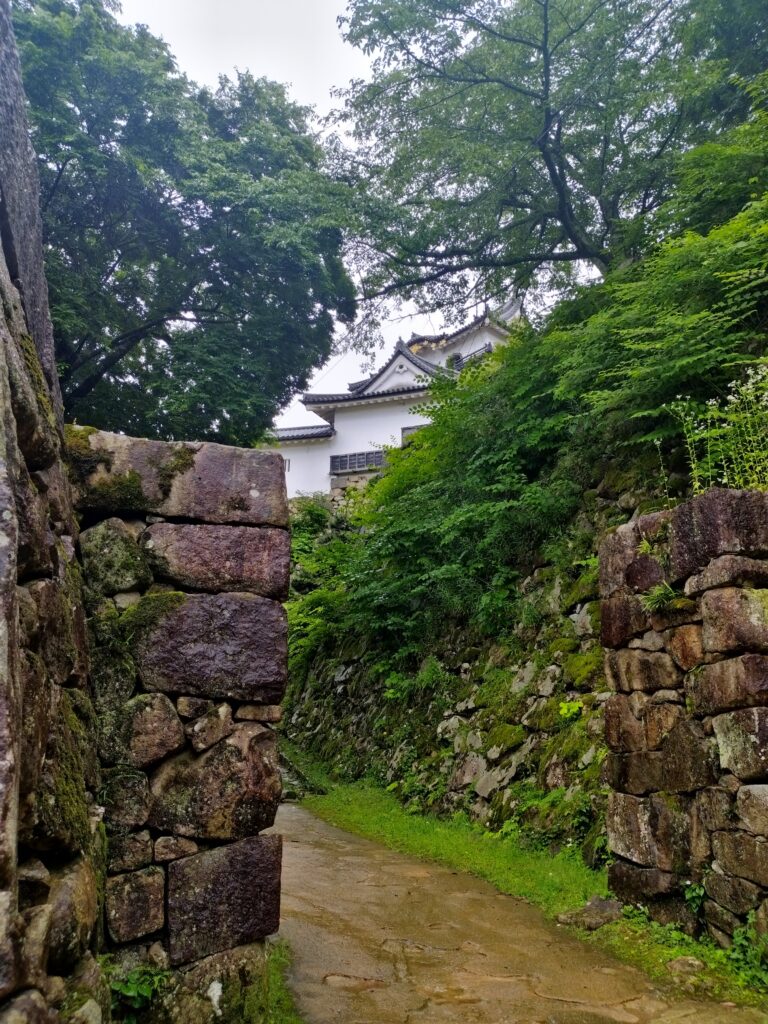
Q1:何故天守閣はこんなに数が減ったのですか?
”Why are there so few castle keeps?”
ここでは実際に現場で受ける質問をベースに天守閣の歴史に関する表現を多めに織り込んで見ました。前半(1-5)が説明にも使える真面目パート、後半(6-10)が雑談力UPを意図したおふざけパートです。👄本パート表現の習得用音声ツールはこちらから。
- Ironically, when the number of castle towers reached its peak, the civil war era ended and the need disappeared.
- 皮肉なことに天守閣の数がピークに達した頃に内戦時代が終わってニーズがなくなりました。
- Additionally, since they were made of wood, they were prone to fires caused by lightning, etc., and the huge cost of rebuilding was a bottleneck.
- また、木造なので、落雷等による火災も多く、再建に莫大な費用がかかることもネックでした。
- Furthermore, due to the government’s castle reduction laws at that time,
the number of castle towers became as it is today .- 更に当時の政府の城削減の法律の影響もあり現在の数になったわけです。
- While they could be used as observation decks, they were too costly, as they were primarily used by the lords’ families.
- 展望台としては使えましたが、領主の一族が使うだけではコスパが悪すぎました。
- Therefore, even the surviving castle towers were in a state of disrepair due to insufficient maintenance funds.
- その為、現存する天守閣でも管理費用不足で、殆どボロボロでした。
- However, with the increase in foreign visitors after modernization, the castles considered to be useless have become recognized as a tourist resource.
- ただ近代化以降、外国人が増えるにつれ、いままで見向きもされなかった城が観光資源になることがわかりました。
- As a result, extensive efforts were made nationwide to restore and maintain castle keeps, leading to the current castle boom.
- その為、全国各地で天守閣の整備が大幅に進み、現在のお城ブームになったのです。
- In Japanese, when something becomes popular, it is literally translated as “igniting fire to a boom.”
- 日本語では,あることがブームになることをブームに火がつくと言います。
- .In this case, it was the increase of foreign tourists that sparked the boom.
- 今回は外国人観光客がブームの火付けやくとなったわけてす。
- However, there is a concern that excessive foreign visitors may further intensify the boom and raise the risk of fires to the castle keeps.
- でも余り外国人が多すぎるとブームが加熱して、本当に天守閣が火事にならないか心配です。
- でも余り外国人が多すぎるとブームが加熱して、本当に天守閣が火事にならないか心配です。
👉Glossary(用語)
reach its peak(ピークに達する) prone to fires(火事になり易い)observation decks(展望台)too costly(コスパ悪すぎ)a state of disrepair(ボロボロ状態)modernization(近代化)tourist resource(観光資源) restore and maintain(復元と維持)excessive foreign visitors(外国客多すぎ)intensify the boom(ブーム加熱)
4. 城門

4.1 基本情報
いつも通り、城門を一緒に観ながら、あれば安心のネタ(押さえておきたい基本情報)です。今回は情報量がかなり多いので、日英パートを別々にせず、一文毎にペアで置きました。
👉音声サンプルは各文も長いので3つに分けました。今回は珍しく米国女性3タイプ。微妙な違いをお試しくださいませ。👄本パート表現の習得用音声ツールはこちらから。
- 日本の城門には戦時の防衛だけでなく,高い建築技術で領主の力と財力を示す目的がある。
- Japanese castle gates serve not only for wartime defense but also to demonstrate the power and wealth of the lord through advanced architectural techniques.
- 敵が本丸まで簡単に侵入できないように複数の門が迷路の様に複雑に配置されている。
- Multiple gates are intricately arranged like a maze to prevent easy access for enemies to the lord’s headquarters.
- 城門自体には防御だけでなく攻撃を考慮した工夫がされている。
- The castle gates themselves are designed not only for defense but also with consideration given to offensive tactics.
- 元々は一門だけであったが時代が進むと共に2つの門と石垣で囲む枡形門が定着した。
- Originally, a castle gate consisted of only one gate, but as time passed, it became common to construct a square area enclosed by two separate gates and stone walls.
- 侵入者をその枡形の中に閉じ込めて殲滅するよう作られた。
- The castle gates were built with the intention of confining invaders within the square areas and completely destroying them.
- 最初の外の門と次の奥の門は右側に直角に配置されている。
- The first outer gate and the next inner gate are positioned at a right angle on the right side.
- 敵は90度、向きを変えるためその勢いを止めなければならなっかた。
- The enemy had to change their direction by 90 degrees, which slowed down their momentum.
- 右側に配置された理由は日本人は右利きが多いので、敵の反撃をワンテンポ遅らせる為だった。
- The reason for the right-side placement is that many Japanese people are right-handed, so it was intended to delay the enemy’s counterattack by one beat.
- 2番目の門の上には櫓が乗っていて、その格子窓や石落としから、侵入者に攻撃を加えることもできた。
- On top of the second gate, there was a turret that could be used to attack invaders through its lattice windows or by dropping stones.
- 最初の外の門は隙があればすぐ外にも攻撃できるように内開きになっている。
- The first outer gate opens inward to enable immediate counterattacks if there are any vulnerabilities outside the gate.
- 城門に装飾性を持たせるのは侵入者に財力を示すことで精神的に威圧する意図がある。
- The decorative elements of the castle gates are intended to mentally intimidate intruders by showcasing the lord’s wealth.
- 城門は役割で見ると正門(大手門(おおてもん)と裏門(搦手門と)の二種類に分けられる。
- When considering their roles, castle gates can be divided into two types: the main gate (‘ote-mon’ meaning ‘big hands’ ) and the back gate (‘karamete-mon’, meaning ‘squeeze hands’).
- 正門は大きく堅固で防御力が高く、格式高く作られるのが特徴。
- The main gate is large, robust, and characterized by high defensive capabilities and grandeur.
- 裏門は一般的に正門に比べて質素だが、中には正門の様に豪華な裏門もある。
- The back gate is generally more modest compared to the main gate, but there are also luxurious back gates similar to the main gate.
- 湾曲した非対称の屋根を置くことで門の装飾性を高め、領主の財力を誇示している。
- The curved and asymmetrical roof design enhances the decorative nature of the gate and displays the lord’s wealth.
👉Glossary: offensive tactics(攻撃) positioned at a right angle(直角に配置)momentum(勢い)any vulnerabilities(どんな隙でも)delay by one beat(ワンテンポ遅らせる)counterattack(反撃) lattice window(格子窓)invader、intruder(侵入者)open inward(うち開き) grandeur(格調高さ)modest(質素な) luxurious(贅沢な) asymmetrical(非対称の)
4.2 インバウンドの視点
城門に限らず、日本の城を始めて見るインバウンドはどこが見所なのかそれ自体わからないようですが、実際に(城門の中を歩きながら)聞かれる質問を含め主な興味ポイントを纏めました。英語音声は前半(1-5)と後半(6-10)の2ファイルに分かれています。👄本パート表現の習得用音声ツールはこちらから。
Q: 想定質問
《日本語》
- 日本の城門の見処、特徴は何ですか?
- 他の古い建造物(寺院、屋敷)の門と何処が違うのですか?
- この様な城門はいつ頃できたのですか?
- (木造建築自体が珍しいので)木造で大丈夫なのですか?
- 城門は何の木材を使っているのですか?
- 全国にある城の城門は同じ構成ですか?
- 城門の正門にはどんな意味があるのですか?
- どうしてそれぞれの城門に違った名前がついているのですか?
- 城門は通常は空いているのですか?
- 城門ではどのような防御策が施されていましたか?
《英語》
- What are the features and characteristics of Japanese castle gates?
- How do they differ from the gates of other ancient structures like temples and mansions?
- When did this type of castle gate first pop up?
- Are they sturdy enough, being made of wood?
- What type of wood is used for castle gates?
- Are castle gates the same in every castle across Japan?
- What was the significance of the main gate of a castle?
- Why do different castle gates have different names?
- Were castle gates usually open?
- What kind of defensive measures were implemented at castle gates?
A:回答例
《日本語》
- 城門は時代の推移と戦争技術の進歩により多様に進化しました。
- 防御力と攻撃力と装飾性を兼ね備えた城独自の桝形門が定着しました。
- 初期数世紀に見られた木製柵から発展し、16 世紀にこの様に最もよく知られた形になりました。
- 門扉には鋲で鉄板を止めて強化し、戦時は内側から岩や材木で塞いで敵の侵入を防ぎました。
- 門柱、梁、櫓の壁や床などに強度のある檜、ケヤキ、杉、松などを使っています。
- 基本構成は同じですが、大きさや配置の仕方が異なったり、唐門、唐破風などで装飾性を加えた門もあります。
- 通常住宅と考え方は変わらず、正門は領主の出入り口で、それ以外の者たちは裏門を使いました。
- それぞれの門を作った経緯や縁起の良い名前を付けて防衛力や権威を高めようとしました。
- 平時でも通常は閉まっていて、日常の出入りは脇の小さな出入口を使っていました。
- 門の上に設けられた櫓からは、石を落としたり、鉄砲や弓で攻撃したりすることができました。
《英語》
- Castle gates have changed a lot over time because of advancements in warfare technology.
- They ended up having this cool rectangular gate that combined defense, offense, and good looks all in one awesome structure.
- They evolved from the wooden stockades of earlier centuries and came into their best-known form in the 16th century
- The gate doors were reinforced with iron plates and during war, sealed tightly with rocks and wood to deter enemy intrusion.
- They used sturdy woods like cypress, zelkova, cedar, and pine for gate pillars, beams, tower walls, and floors to make sure they lasted.
- Their basic configuration is similar, but they vary in size, placement, and may feature decorative elements like Karamon (Chinese-style gate) or Karahafu (undulating gable) to enhance their appearance.
- Similar to a typical residence, the main gate was primarily for the lord’s entry and exit, while others would use back gates.
- They were named based on the circumstances of their construction, or given auspicious names to enhance their perceived defensive power and the lord’s authority.
- Even during peacetime, they were typically kept closed. Daily entry and exit usually happened through smaller side entrances.
- From the yagura (tower) built above the gate, stones could be dropped, and firearms or arrows could be fired at attackers.
Glossary
over time(時代が変わり)advancements in warfare technology(戦争技術の進歩)end up (定着する)cool rectangular gate(見事な枡形門)combin all in one(兼ね備える)defense, offense, and good looks(防御、攻撃、美観)awesome structure(恐るべき造り).wooden stockades(木の柵)earlier centuries(初期数世紀)best-known form(よく知られた形) be reinforced with(強化された) iron plates(鉄板) during war(戦時)sealed tightly with(きつくふさぐ)deter enemy intrusion(敵の侵入を防ぐ)sturdy woods(頑丈な木材)zelkova(ケヤキ)to make sure they last(強度確保のため) gate pillars(門柱) beams(梁)
4.3 笑いが取れるかも?説明例
Q1:何故、枡形門が定着したの?
“Why did the box-shaped gate become established?”
👉いつもの真面目(No.1-5)&不真面目(6-12)パターンですが、前半はインド女性が不思議そうに、後半はかつてのインドの宗主国イギリスの女性(実はラスト2文は良心の声=米国女性)が冷静分析調で語ります。👄🎤本パート表現の習得用音声ツールはこちらから。
- Originally, the castle gate was a simple structure, reinforcing the regular entrance with watchguards.
- 元々は通常の出入り口の門を警備強化した単純な構成だったのです。
- However, as warfare technology advanced, it evolved into a square-shaped structure.
- しかし戦闘技術が進むに連れて、進化してこのような枡形になりました。
- With two gates and stone walls surrounding them like a trap, enemies would be easily killed.
- 袋の鼠のように2つの門と石垣に囲まれて,容易に殺されてしまうのです。
- But what is intriguing is that this square-shaped gate was the norm at the time, so the enemy should have been aware of it.
- でも、不思議に思うのは、この枡形門は当時の常識だったので、敵もその事は分かっていたはず。
- Why would they willingly fall into such a trap like mice?
- わざわざその罠に自ら入るようなことをしたのでしょうか?
- One possible explanation is that soldiers had no choice but to move forward, even if they knew they would die.
- 考えられることは、死ぬと分かっていても兵隊とすれば前に進むしか、手はなかったのかもしれません。
- If they didn’t advance, they would be denounced as deserters or cowards, bringing shame upon their descendants for generations.
- 前に進まなければ敵前逃亡を理由に裏切り者か卑怯者と子孫の代まで罵られるわけです。
- However, mice have strong reproductive power, leaving behind 10,000 offspring in a year from a pair of mice.
- でも、ネズミは繁殖力が強く二匹のつがいから一年で1万匹の子孫を残します。
- So, perhaps mice might die peacefully in a mousetrap for the sake of their descendants’ honor.
- なのでネズミなら子孫の名誉の為にネズミ捕りで安心して死ねるかもしれません。
- But most human soldiers are young, unmarried individuals.
- でも人間の兵士は殆どが結婚前の若者です。
- If they die, they cannot leave behind any descendants or honor, can they?
- 死んだら子孫も彼らの名誉も残せませんよね。
- So, many samurais married at a young age, often in their early teens.
- だからサムライは結婚が早かったんですね。十代前半での結婚が多かった。
- Perhaps it was a good time for young people who’d say, ‘I don’t care about my life as long as I can get married,’ a sentiment that remains true throughout history.
- いつの時代にもいる「死んでもいいから結婚したい」って言う若者には良い時代だったのかも。
- But no one can say whether they’d be happy if, in their early teens, they already understood what marriage really meant—that the castle gate wasn’t the only mousetrap.
- でも十代の若さで結婚の本当の意味を知るのが幸せなのかわかりませんけどね、城門だけがマウトラップじゃないって事をね。
👉Glossary:watchguards(警備)warfare technology(戦闘技術)the norm at the time(当時の常識)denounce(罵る) deserter(裏切者)coward(臆病者)mice(ネズミ)reproductive power(生殖力)leave behind offspring(子孫を残す)descendants’ honor(子孫の名誉)
5. 石垣

5.1 基本情報
ご存知の通り、石垣は古来より世界のあらゆる文明で見ることができますので、日本の独自性にポイント置きました。お城ファンに定番の3種類の石垣「野面積(のづらづみ)」「打込接(うちこみはぎ)」「切込接(きりこみはぎ)」ネタは、多くのインバウンドには細かすぎるので外してます。石垣マニアの外国人には地元のパンフレット(石垣自慢のお城には必ず英語説明ありますので)がおススメです。👄本パート表現の習得用音声ツールはこちらから。
《日本語》
- 日本の石垣は西洋と違ってモルタル、漆喰を使わず石だけで積まれている。
- 日本は木材が豊富なので西洋家屋と違い石垣は建物の基礎として一般的に使われてきた。
- 現在の著名な城の石垣は戦国時代に急激に発展した特殊なもの。
- 自然石を積み上げた単純なものから切石を美しく積み上げた芸術的レベルのものまで色々な石垣が見られる、
- 天守や城門と同様、守りと攻撃用途だけでなく相手を怯ませる財力と威厳を示す意図が込められた。
- 石垣の構築には石の選定から加工、積み上げ方に至るまで、高度な専門知識と熟練技術が求められた。
- 戦国時代には高度な石工技術を持つ特定の専門集団が全国で活躍した。
- 平和な時代になり需要が減少すると共に技術継承が困難になった。
- 高く積み上げられた石垣には、上部に行くほど傾斜角度が上がる美しい曲線がみられる。
- 傾斜を徐々にきつくすることで安定性を高め登攀を困難にする機能的な意味合いがある。
《英語》
👉音声サンプルは前半(1-5)は石垣で有名なウェールズの男性話者、後半(6-10)は城の石垣のないオーストラリア女性話者です。
- Japanese stone walls are built only with stones, unlike Western ones that use mortar and plaster.
- In Japan, due to the abundance of wood, stone walls have been commonly used as the foundation of buildings, unlike Western houses.
- The stone walls of famous castles today are unique structures that rapidly developed during the Warring States period.
- You can see various types of stone walls, ranging from simple ones made of natural stones to artistically crafted ones made of cut stones.
- Similar to the keep and castle gates, these stone walls were intended not only for defense and attack but also to intimidate the opponent with their wealth and dignity.
- The construction of stone walls required a high level of expertise and skill from the selection of stones to processing and stacking methods.
- During the Warring States Period, specific specialized groups with advanced masonry skills were active throughout the country.
- In times of peace, demand decreased and it became difficult to pass on the specialized techniques.
- Stone walls piled high have beautiful curves where the angle of inclination increases toward the top.
- The gradual tightening of the slope has a functional meaning of increasing stability and making it difficult to climb.
5.2 インバウンドの視点
石垣を見た多くの外国観光客の第一印象は日本人とそれほど変わらないようです。👄本パート表現の習得用音声ツールはこちらから。
- こんなに大きな石材をどうやって運んだのか?
- こんなに大きな石材をどうやって積み上げたのか?
- どうやってこれだけの石を切り出したのか?
- なぜわざわざこんな大きな石を使うのか?
- 石垣の高さはどれくらいなのか?
- 造ってからどれくらい経っているのか?
- どうしてくずれないのか?地震でも大丈夫なのか?
- 日本の石垣はどんな石を使っているのか?
- 石垣の石はどこから持ってきたのか?
- どうして隙間なく表面を整えられるのか?
英訳例
👉石垣とは無縁のヤンキー娘が無邪気に尋ねます。
- How did they manage to move such huge stones?
- How did they stack those massive stones?
- How did they cut out so many stones?
- Why did they choose to use such big stones?
- How tall is the stone wall?
- How long ago was it built?
- Why doesn’t it fall apart? Is it earthquake-proof?
- What type of stones have been used in Japanese stone walls?
- Where were the stones for the stone wall brought from?
- How did they achieve such a smooth surface without any gaps?
日本語回答例
いつも通りの単純な表現例として。
- 石を移動する為の舟を造り道を整備して時間をかけて運んだ。
- 基本的には一番下に大きな石を置き順番に石を重ねて作った。
- 予め掘られた石の割れ目に鉄のクサビを刺して叩いて石を割った。
- 石垣作業を請け負った大名の威信を示すため、石の大きさで競われた。
- 高いのものは約30m(100フィート)マンション10階建てになる。
- 石垣は火事被害の多い木造部分と違い、築城当時のままのものが多い。
- 石垣の四隅の石を交互に積むことで強度アップがされ、地震にも強い。
- 硬くて加工しやすく風化しにくい「花崗岩」がよく使われていた。
- 全国各地の高品質の石が取れる場所からブランド力のある石が選ばられた。
- 石加工技術の著しい向上によるが、領主たちに余裕ができた時代だった。
英語回答例
👉全体長いので音声サンプルは2つに分けました。前半英国男性、後半オーストラリア女性との、石を二つに割るような対照的な声。
- They spent a lot of time building ships and making roads to move the stones around.
- Basically, they placed the largest stones at the bottom and stacked the other stones on top of each other in order.
- They stuck iron wedges into the cracks they made in the stones and hammered them to split the stones apart.
- To show off how great the lord was who undertook the construction of the stone walls, there was a competition based on the size of the stones.
- The biggest ones were like 100-foot-tall buildings, about as high as 10-story mansions.
- Unlike the wooden buildings that were prone to fire damage, many of the stone walls remain as they were when the castle was built.
- By stacking the stones at the corners of the stone walls alternately, the strength was enhanced, making them more resistant to earthquakes.
- They commonly used “granite,” a tough and weather-resistant stone that was also easy to work with.
- They carefully chose high-quality stones from different parts of the country for their brand value.
- It was a time when lords had more free time, which allowed for significant improvements in stone processing technology.
5.3 笑いが取れるかも?説明例
👉《笑いがとれるかも?》パートについて:一目みて素朴に思うであろう想定疑問への説明例として、基本的に前半部は説明にも使える真面目パート、後半部は雑談力UPの為のおふざけパートの2部構成になっています。
Q1:トラックも重機もなくてどうやったの?
“How did they manage to build it without any trucks or heavy machinery? “
👉今回は墓石に関する表現を多めに織り込んでみました。前半(1-5)は真面目パート。後半(6-10)はふざけパートです。👄本パート表現の習得用音声ツールはこちらから。
- It seems that everything was sourced locally in the beginning, as it was a labor-intensive age.
- 当時は全て人力で時間がかかるので最初の頃は全て現地調達だったそうです。
- Even the biggest castles in Japan at that time were constructed by gathering materials from nearby areas.
- 日本を代表的する当時最大規模のお城も同様、近場から集めました。
- They brought in any usable stones they could find, from tombstones in temples to foundation stones from neighboring ancient palaces.
- お寺の墓石から、近くの古代宮殿の礎石など、使えそうな石はなんでも持ち込まれました。
- They particularly valued high-quality granite tombstones.
- 特に上質の御影石を使っていた墓石は重宝されたようです。
- But I wonder if they didn’t worry about curses or bad luck when using tombstones as the foundation for castles?
- でも墓石をお城の基礎に使って、祟とか気にしなかったのでしょうか?
- We can understand that when the lord gave orders, there was no choice but to follow without thinking about the consequences.
- 領主に命令されたら後先考えず、とりあえず従うしかありませんけど。
- However, many lords and their families eventually met their downfall along with their castles.
- でも、多くの領主やその一族は遠からず城と共に滅ぼされています。
- Maybe it was because they used tombstones as foundation stones showing no respect.
- お墓なんか基礎石に使って踏みつけたからかもしれませんよ。
- Ironically, they may have dug their own grave by digging other people’s tombstones.
- 皮肉にも、彼らは他人の墓石を掘って、自らの墓穴を掘ってしまったのかもしれませんね。
- That’s why most guides steer clear of this grave topic—they don’t want to dig their own grave by being misunderstood as raising grave (serious) issues.
- だから殆どのガイドはこのネタを使わないんです。誤って深刻に解釈されて自分の墓穴を掘りたくないので。
6. 堀
6.1 基本情報
ご存知の通り、堀は西洋のお城にもありますので、日本の独自性も含め10項目でまとめてみました。英語音声は前半(1-5)米国女性話者、後半(6-10)米国男性話者の2ファイルです。
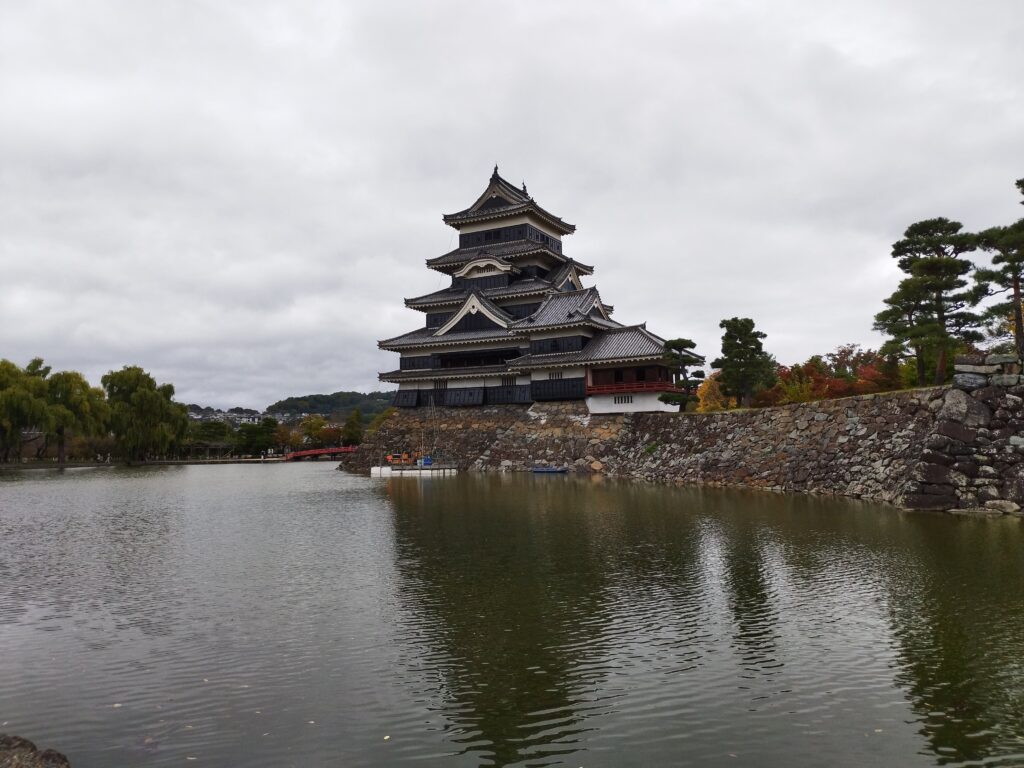
《日本語》
- 堀は、敵から城を守るための最も重要な防御線であり、主に水で満たされた水堀と、水のない深く掘られた空堀の2種類に分けられる。
- 堀は単なる溝ではなく、堀の底に畝(うね)をつけたり(畝堀)、複雑な迷路のように区切ったり(障子堀)と、敵の侵入を妨げるための様々な工夫が凝らされていた。
- 堀は、山、川、湿地、そして時には海といった自然の地形を巧みに利用して築かれた。これにより、自然の険しさがそのまま防御障壁として機能した。
- 堀の水源は、雨水や湧き水だけでなく、遠く離れた上流の川から、あるいは直接海から水を引くこともあり、当時の高度な土木技術が活用されていた。
- 堀は単なる物理的な防御のために造られただけでなく、大きく、広く、深く造られることで、城主の富と権力を象徴し、潜在的な敵の攻撃を思いとどまらせる意図があった。
- 多くの平城や平山城には、複数の内堀と外堀があり、敵の侵入を防ぎ、攻撃を遅らせるための段階的な防御システムを形成していた。
- 堀は一般的に数メートルの深さがあり、中には10メートルを超える深さや数十メートルもの幅を持つものもあり、潜在的な敵にとっては手強く、その深さは計り知れないものだった。
- 多くの堀は、時が経つにつれて埋め立てられたり、土砂が堆積したりしたため、築城当時の深さを保っているわけではないが、その本来の深さは現代人にとってもしばしば計り知れない。
- 堀は敵の侵入を防ぐだけでなく、城内の居住者の移動経路、物資の輸送経路、そして緊急時の避難経路としても機能した。
- 現代では、不衛生あるいは邪魔と見なされた多くの堀が埋め立てられたが、中には道路に転用されたり、公園で小型遊覧船による観光に利用されたりしているものもある。
《英語》
- Moats, the most important defensive lines for protecting castles from enemies, are mainly divided into two types: moats filled with water (water moats) and deep moats without water (dry moats).
- Moats were not simply ditches, but were designed to hinder the advance of enemies through various ingenious methods, such as creating ridges at the bottom of the moat (une-bori) or dividing them into a complex, maze-like pattern (shōji-bori).
- The moats were skillfully constructed using natural terrain such as mountains, rivers, marshes, and sometimes even the sea, so that the ruggedness of the natural environment served as a defensive barrier.
- The moat was sourced not only by rainwater and spring water, but also by water drawn from distant upstream rivers and directly from the sea, utilizing the advanced engineering techniques of the time.
- Moats were not only built for physical defense, but also to be large, wide, and deep, as symbols of the castle lord’s wealth and power with the intention of discouraging potential enemies from attacking.
- Many flatland or flatland-mountain castles had multiple inner and outer moats, forming a tiered defense system designed to prevent enemy intrusion and slow down attacks.
- Moats were generally several meters deep, and some are over 10 meters deep and dozens of meters wide, making them formidable and difficult for potential enemies to fathom.
- Many moats have been filled in or silted up over time, so they don’t have the same depth as when the castle was first built, making their original depths often unfathomable to modern people as well.
- The moat not only prevented enemy invasion, but also served as a route for the movement of residents within the castle, a transportation route for supplies, and an evacuation route in case of emergency.
- In modern times, many moats have been filled in as they were considered unsanitary or obstructive, but some have been converted into roads or used for sightseeing purposes by small pleasure boats in parks.
6.2 インバウンドの視点
堀は見どころが難しいので外国観光客の第一印象は様々ですが、いくつかはしばしば聞かれる質問です。英語音声については、質問は短いので10文1ファイル(インド女性話者)、回答は前半(1-5)は英国男性話者、後半(6-10)はオーストラリア女性話者の2ファイルです。
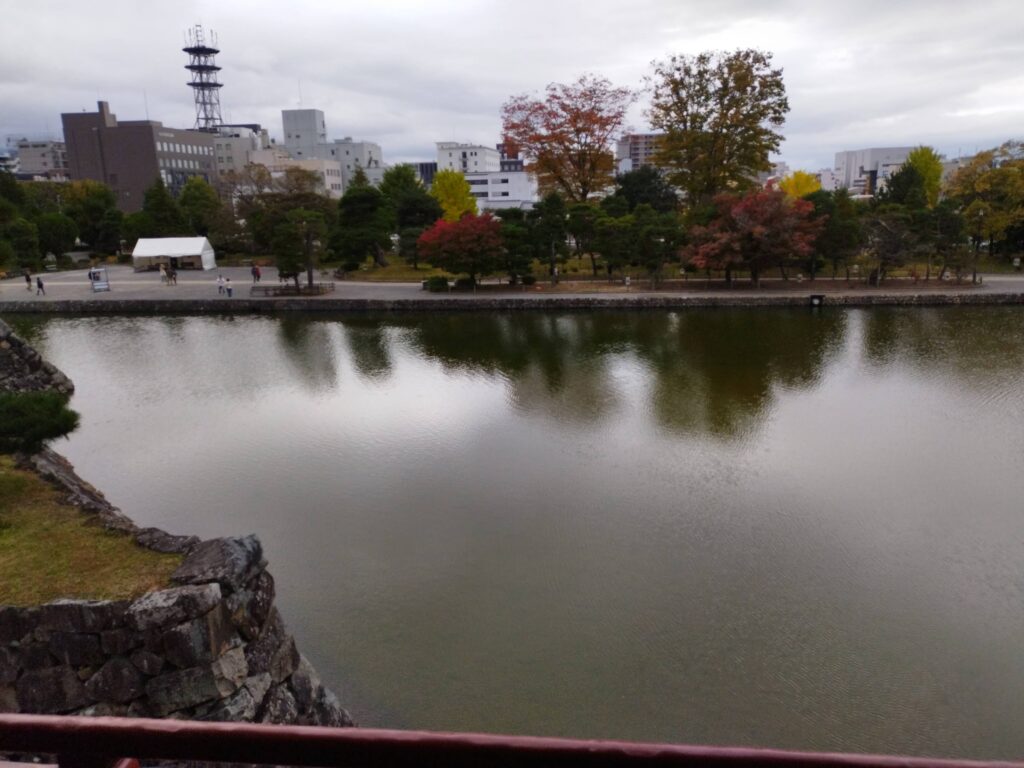
《日本語》
- Q: この水はどこから来ているの?
- A:城の堀に使われる水は、城の立地によってさまざまです。雨水や自然の湧き水を利用する場合もあれば、遠くの川から運河を通じて引き込まれていることもあります。
- Q: 冬に堀が凍ったりするの?
- A:はい、寒冷地の城では、冬に堀が凍ることがあります。その氷が敵にとって渡りやすくなるため、氷が人の重さに耐えられるほど厚くなった時期には、警備員が見張りをしていたとも言われています。
- Q: この堀って、実際どれくらい深いの?
- A:堀の深さは城によってかなり違いますが、一般的には数メートルあり、10メートルを超えるものも存在します。幅と深さの両方があることで、敵にとって非常に厄介な障害物となっていたのです。
- Q: これまでに誰かが堀を渡って攻撃したことは?
- A:もちろんあります。多くの城では堀の周辺で激しい戦闘が繰り広げられました。兵士たちが堀を土砂で埋めようとしたり、強引に渡ろうとした記録がいくつも残っています。
- Q: なんでこんなに堀の幅が広いの?
- A:堀の幅が広いのは、防御だけでなく敵を威圧する目的もありました。「この城を攻めるのは不可能だ」と思わせることで、領主の圧倒的な権力や財力を誇示していたのです。
- Q: この城には、なんでこんなに堀が多いの?
- A:多くの城には、内堀と外堀といった複数の層からなる堀が設けられていました。こうした重層的な防御は、城の中心にいる領主とその家族だけでなく、周囲に住む家臣や町人の安全も守るためのものだったのです。
- Q: 水のない空堀があるって聞いたけど、なんで?
- A:おっしゃる通りです。空堀(からぼり)は、主に山城など水の確保が難しい場所で使われました。単なる溝ではなく、底が入り組んだ迷路状になっていたこともあり、侵入者を混乱させて足止めする狙いがありました。
- Q: 堀に人が落ちたりしないの?
- A:残念ながら、そうした事故は時折起こります。特に夜間、酔った人がふらりと堀の周辺を歩いていて、足を滑らせて落ちる事例もあるようです。
- Q: 今、この堀にはどんな生き物がいるの?
- A:現在では、多くの堀が豊かな自然生態系を育んでいます。鯉やフナなどの魚類、カモやカワセミといった水鳥も見かけることができます。街中に広がる貴重な水辺の楽園ですね。
- Q: 日本の城の堀は、ヨーロッパの城とどう違うの?
- A:どちらも防御を目的としていましたが、日本の堀は底に畝状や迷路状の構造を取り入れるなど、より複雑な設計が見られます。さらに、高くそびえる石垣と組み合わせることで、強固な防御性と美的な魅力の両立を図っていたのです。
《英語》
- “Where does all this water come from?
- “The water for castle moats comes from various sources depending on the castle’s location. Some moats use rainwater or natural springs, while others are fed by canals that bring water from distant rivers. “
- “Does the moat ever freeze in winter?”
- “Yes, in colder regions, moats can indeed freeze over in winter. This could potentially make it easier for enemies to cross. Because of this, it’s said that security guards would keep watch when the ice was thick enough to walk on.”
- “How deep is this moat, really?”
- “The depth of castle moats varies greatly, but they are generally several meters deep, with some exceeding ten meters. Combined with their width, this made them very difficult obstacles for attackers.”
- “Did anyone ever try to cross this moat to attack the castle?”
- “Absolutely, fierce battles were often fought right around the moats of many castles. There are numerous historical accounts of soldiers attempting to fill the moats with dirt and debris or trying to force their way across them.”
- “Why are some of these moats so incredibly wide?”
- “Wide moats served multiple purposes beyond just defense. They were also built to intimidate enemies by making the castle appear incredibly difficult to attack, thereby showcasing the lord’s immense power and resources.”
- “Why are so many moats in this one castle?”
- “Many castles featured multiple layers of moats (inner and outer moats) to create a tiered defense system. This not only protected the lord and his family at the castle’s core but also provided a defense for the vassals and citizens living in the surrounding areas.”
- “I heard there are dry ditches, without water. Why?”
- “You’re right! Dry moats (karabori) were often used in mountain castles because it was difficult to secure enough water there. These weren’t just simple ditches; they often had a complex, maze-like structure at the bottom to slow down and confuse any invaders.”
- “Doesn’t anyone sometimes fall into the moat?”
- “Unfortunately, yes, accidents do happen. Especially at night, there are numerous cases of people walking around the moat, perhaps while intoxicated, losing their footing, and falling in.
- “What kind of animals or fish live in these moats now?”
- “Today, many moats are home to diverse wildlife. You can often spot fish like carp and crucian carp, as well as various water birds such as ducks and kingfishers. They form a valuable waterfront ecosystem right here in the city!”
- “How are Japanese castle moats different from those in European castles?”
- “While both served defensive purposes, Japanese castle moats often had more complex designs at the bottom, like ridges and maze-like patterns. Also, they were intricately combined with towering stone walls for both strong defense and remarkable aesthetic beauty.”
6.3 笑いが取れるかも?説明例
堀を一目みて素朴に思うであろう想定疑問への笑いも意図した説明例です。
Q1:なぜ多くの堀には柵がないの?
“Why are many moats open without fences?”
先のQAにもある質問ですが、ここでは現代の堀の課題に関する表現を織り込んで見ました。前半(1-6)が説明にも使える真面目パート、後半(7-10)が雑談力UPを意図したおふざけパートですが、今回は全体短いので、英語音声は1ファイル(話者)で置きました。
《日本語》
- もともと、城の堀は庶民と支配階級を隔てる神聖な境界線としての役割を果たしていました。
- その危険なまでの開放性は、文字通り「この線を越えるな」という警告だったのです。
- 現代では、多くの堀が当時の姿のまま、あるいは美しく復元され、柵は設けられていません。
- 城は観光名所として人気がありますが、安全柵がインスタ映えの写真に映り込んでは台無しですからね。
- しかし、その開放性は自撮りだけでなく、悲しいことに酔った人の転落も招きがちです。
- 国の文化財の前に注意喚起の看板を立てるのは避けたいものです。
- もちろん、中世の戦法のように堀を埋めるなんて不可能です。
- 唯一できる対策は、目立たない小さな看板を設置することくらいでしょう、でも現地の光景に夢中な観光客には、そんな看板など見えていないことも少なくありません。
- 結局、これは「どちら側にも決めかねる」——“sitting on the fence(どっちつかず)”のような状況かもしれません。
- ただし……ご覧の通り、実際には「座るための柵」すら存在しないのです。
《英語》
- Originally, castle moats marked the sacred divide between commoners and the elite.
- Their dangerous openness signaled, quite literally, “Do not cross this line.”
- Today, most moats remain unfenced—either preserved in their original glory or beautifully restored.
- Castles are tourist magnets, and no one wants a safety railing photobombing their perfect Instagram moment.
- But that openness invites not just selfies but, tragically, the occasional tumble—especially by intoxicated visitors.
- We want to avoid putting up warning signs in front of national treasures.
- Of course, it’s impossible to fill in the moat, like in medieval warfare.
- The only measure is to post small, discreet signs—but many visitors, absorbed in the scenery, fail to notice them.
- In the end, it might resemble a “sitting on the fence” situation.
- Except… there’s no actual fence to sit on, as we’ve already discussed.
7. 屋根
7.1 基本情報
日本の屋根は多くのインバウンドに珍しいので、実際の関心点も踏まえ10項目にまとめてみました。屋根の形式の日本語の名前は現場では殆ど使いません(建築専門家以外は不要)が、ご自身の理解の為(日本語でも紛らわしいので)付記しました。英語音声は前半(1-5)米国女性話者、後半(6-10)米国男性話者の2ファイルです。

《日本語》
- 城の屋根は、雨風から建物を守るだけでなく、遠くから際立って見えることで、城主の権力と権威を示すよう設計されている。
- 天守閣や櫓の屋根は、複数の屋根様式を組み合わせることで、より美しく立体的に見えるよう設計されている。
- 屋根様式には主に2種類あります。「切妻造り(きりづまづくり)」は開いた本のような三角形の屋根で、「寄棟造り(よせむねづくり)」は四方向に傾斜がある(ピラミッド型とも表現される)屋根である。
- 多くの天守閣は「入母屋造り(いりもやづくり)」という屋根構造を特徴としており、上部が二方向に傾斜する切妻屋根、下部が四方向に傾斜する寄棟屋根となっている。
- 多くの城には、屋根の妻側にある三角形の装飾的な要素である「破風(はふ)」があります。その中には、特徴的な曲線を描く屋根を持つ「唐破風(からはふ)」もある。
- 多くの城には通気と装飾を目的として「千鳥破風(ちどりはふ)」という、主屋根の傾斜部分に配置された小さく、複数の破風が組み込まれている。ある説によると、それらの配置は、まるで何羽もの鳥が羽ばたいているような姿を連想させるとのこと。
- 屋根の棟の端には、顔の形をした装飾瓦「鬼瓦(おにがわら)」が置かれている。これらは悪霊や火災を遠ざけると信じられており、城によってデザインが異なる。
- 天守閣の屋根の最上部には、「鯱(しゃちほこ)」と呼ばれる想像上の生き物がいる。これらは魚の体に虎の顔を持ち、火災に対する守り神としての役割を果たしている。
- ほとんどの屋根瓦は、高温で焼かれた土や粘土でできており、非常に耐火性が高く丈夫で、何世紀にもわたって使われてきた。
- 屋根全体を美しく、独特な白い外観にするために、一部の城では木造屋根の表面を鉛の板で覆った「鉛瓦(なまりがわら)」も使われた。

《英語》
- The roof of a castle is designed not only to protect against rain and wind, but also to assert the lord’s power and authority by standing out prominently from a distance.
- The roofs of the castle tower and turrets are designed to look more beautiful and three-dimensional through the combination of multiple roof styles.
- There are two main types of roof style: Kirizuma-zukuri, a gabled roof with a triangular surface resembling an open book, and Yosemune-zukuri, a hipped roof with slopes on all four sides (sometimes described as pyramid-shaped).
- Many castle towers feature an irimoya-zukuri roof structure, with a gabled roof at the top (sloping in two directions) and a hipped roof at the bottom (sloping in four directions).
- Many castles feature hafu (gables), which are the triangular decorative elements at the ends of the roof ridges. Among these are Karahafu (Chinese-style gables), known for their distinctive curved roofs.
- Many castles incorporate chidori hafu, which are smaller, often multiple gables placed on the main roof slope for air circulation and decoration. One theory says their arrangement can sometimes evoke the image of many birds flapping their wings in flight.
- At the ends of the roof ridges, decorative tiles shaped like faces, known as oni-gawara (demon-face roof tiles), are placed. They are believed to ward off evil spirits and fire, with their designs varying from castle to castle.
- At the peak of the castle tower roof, you’ll find imaginary creatures called ‘shachihoko’. These beings, with the body of a fish and the face of a tiger, serve as guardian deities against fire.
- Most roof tiles, made from soil or clay baked at high temperatures, are highly fire-resistant and durable, having been used for centuries.
- To achieve a beautiful and distinctively white appearance for the entire roof, some castles also used lead tiles, where the wooden roof structure was covered with sheets of lead.
7.2 インバウンドの視点
屋根はお城の内部の展示物を見ながら、その構造や素材についてよく雑談にもなりますので、その辺りのネタを考慮して回答はかなり長くなっています。現場での即答は最初の文だけで十分ですが、後は反応を見ながら雑談的に付け足す、そんな感じでチェックされるのがよろしい様に思います。英語音声については、質問は短いので10文1ファイル(インド男性話者)、回答は前半(1-5)は英国女性話者、後半(6-10)はオーストラリア男性話者の2ファイルです。

《日本語》
- Q: この屋根は何でできていますか?
- A: 主に「瓦(かわら)」と呼ばれる粘土を焼いて作ったタイルでできています。瓦の下には、屋根構造全体を支えるために木材が注意深く組まれています。
- Q: 屋根瓦はどれくらいの重さがありますか?
- A: 瓦一枚一枚は数キログラムですが、屋根全体では数トンもの重さになります!このかなりの重さが屋根を安定させ、強風にも非常に強くしています。
- Q: どうしてこんなにたくさんの瓦が屋根に使われているのですか?
- A: たくさんの瓦を積み重ねることで、効果的な層構造が作られます。この設計により雨水が効率的に流れ落ち、建物の中に水が入るのを防ぎます。さらに、これらの瓦の厚みが建物の断熱性を著しく向上させ、火災からも守る役割も果たしています。
- Q: これらの瓦は一枚一枚手作りなのですか?
- A: 歴史的に見て、城で使われた瓦はすべて熟練した職人によって丹念に作られました。今日でも、修復プロジェクトに使われる瓦の多くは、依然として伝統的な方法で手作りされており、本当に高度な技術と職人技が必要です。
- Q: 屋根の端にある鬼の顔のようなものは何ですか?
- A: それは「鬼瓦(おにがわら)」と呼ばれるものです。城の屋根を守る守り神と考えられています。悪霊や火災を遠ざけると言い伝えられており、城によってその表情やデザインが異なるので、ぜひ独特な芸術的な違いを鑑賞してみてください!
- Q: 屋根の上の金色の魚のようなもの(鯱)は何ですか?
- A: それは「鯱(しゃちほこ)」という、城の屋根によく見られる伝説上の生き物です。魚の体に虎の顔を持つと言われています。口から水を噴き出して火を消すと信じられており、強力な防火のお守りとしての役割を果たしています。かつては権力と富の象徴として金箔が施されることもありましたが、その価値ゆえに残念ながら盗まれることもありました。
- Q: 屋根の形がとても複雑ですが、何か特別な意味がありますか?
- A: もちろんです!屋根の複雑な形は、城の威厳と美しさを強調するだけでなく、効率的な雨水排水のような実用的な考慮もされています。例えば、金沢城の石川門にある**唐破風(からはふ)**は、複雑な美しさと水流のための巧みな設計の両方を示しています。
- Q: この種類の屋根はどれくらい持ちますか?
- A: 粘土瓦は信じられないほど耐久性があります。適切にメンテナンスされていれば、100年以上もつことも珍しくありません。実際、多くの城の屋根は何世紀にもわたってその印象的な姿を保ってきました!
- Q: (素材を考えると)落とすと割れますか?
- A: はい。屋根瓦は陶磁器と同じ素材でできているため、落としたり強い衝撃が加わったりすると、確かにひびが入ったり割れたりすることがあります。しかし、屋根瓦は一枚一枚が独立して固定され、互いに少しずつ重なるように設計されています。これにより、構造全体が一度に壊れるのを防ぎ、適切に葺かれていれば非常に高い耐久性を発揮するのです。
- Q: 地震が来ても大丈夫ですか?
- A: 重い瓦屋根は地震の揺れに弱いと思われがちですが、城のような日本の伝統的な木造建築は、揺れを吸収し耐えるように特別に設計された柔軟な構造を持っています。壊れるのではなく、しなるように造られているのです。
《英語》
- Q: What is this roof made of?
- A: It’s mainly made of “kawara,” a type of tile baked from clay. Beneath these tiles, a wooden framework is carefully assembled to support the entire roof structure.
- Q: How heavy are the roof tiles?
- A: Each individual tile weighs a few kilograms, but when you consider the entire roof, the total weight can be several tons! This significant weight helps stabilize the roof, making it very resistant to strong winds.
- Q: Why are so many tiles used on the roof?
- A: Stacking so many tiles creates an effective layering system. This design efficiently drains rainwater away, preventing any water from entering the building. Plus, the thickness of these layered tiles significantly improves the building’s thermal insulation and offers protection against fire.
- Q: Are each of these tiles handmade?
- A: Historically, every single tile used on the castle was meticulously crafted by skilled artisans. Even today, for restoration projects, many tiles are still handmade using these traditional methods, which truly requires a high level of skill and craftsmanship.
- Q: What are those demon-face-like figures at the end of the roof?
- A: Those are called “oni-gawara” (demon-face roof tiles). They’re considered guardian deities that protect the castle roof. They’re believed to ward off evil spirits and fire. The cool thing is, their expressions and designs vary from castle to castle, so you can really appreciate the unique artistic differences!
- Q: What are those golden fish-like figures [shachihoko] on the roof?
- A: That’s a “shachihoko,” a mythical creature often seen on castle roofs. It’s said to have the body of a fish and the face of a tiger. They’re believed to extinguish fires by spouting water from their mouths, so they act as powerful fire prevention talismans. While some had gold leaf to symbolize power and wealth, they were unfortunately sometimes stolen due to their value.
- Q: The roof shape is very complex; does it have any special meaning?
- A: Absolutely! The complex roof shapes not only emphasize the castle’s dignity and beauty but are also designed with practical considerations like efficient rainwater drainage.
- Q: How long does this type of roof last?
- A: Clay tiles are incredibly durable. With proper maintenance, it’s not uncommon for them to last well over 100 years. In fact, many castle roofs have retained their impressive appearance for centuries!
- Q: Do they break when they fall, considering the material?
- A: Yes. As roof tiles are made from the same material as ceramics, they can certainly crack or break when dropped or subjected to a strong force. However, roof tiles are fixed independently and designed to overlap slightly with each other. This prevents the entire roof structure from breaking all at once, making them quite resilient when properly laid.
- Q: Is it safe even during an earthquake?
- A: While heavy tile roofs might seem vulnerable to earthquake shaking, traditional Japanese wooden buildings, like castles, have a flexible structure specifically designed to absorb and withstand seismic forces. They’re built to flex, not break.
7.3 笑いが取れるかも?説明例
一緒に屋根を見ながら素朴に思うであろう想定疑問への笑いも意図した説明例です。
Q1:城の屋根はすべて瓦でできているのですか?
“ Are all the roofs of the castle made of tiles?”
ここでは実際よく話題になる「江戸城」「皇居」を交えた話に纏めました。前半(1-6)(米国男性話者)が説明にも使える真面目パート、後半(7-14)(米国女性話者)が雑談力UPを意図したおふざけパートです。


《日本語》
- ほとんどの屋根は瓦で覆われていますが、将軍家が住んでいた江戸城、のちに現在の皇居となりましたが、では鉛瓦を使用していました。
- 鉛は長い間、雨や日光にさらされることで白く変色し、天候によっては屋根に雪が積もったように見えることもあります。
- 当時の史料では「白く輝いて美しい」と記録されていますが、非常に高価だったため、他の城では使われることはありませんでした。
- 唯一、金沢城も鉛瓦を使用しており、非常時にはそれを溶かして弾丸として使うためだった、という説があります。
- 加賀藩の藩主は幕府に次ぐほどの財力を持っており、常に反乱の疑いをかけられていました。
- 実際に、幕府との戦争に備えて秘密裏に準備をしていたのも事実です。
- しかし冷静に考えると、この説は現実的とは言えません。
- 緊急時に鉛瓦を溶かして弾丸を作る時間などありません。
- 事前に準備していたとしても瓦を外してしまえば屋根は木の骨組みだけとなり、城の基本的な防御力が大きく損なわれてしまいます。
- それでも、そうした鉛瓦の存在は、城下の兵士や町人たちに「いざという時の備えと覚悟」を感じさせる効果があったのかもしれません。
- 悲しいことに、日本が過去に経験した最後の大きな戦争では、政府から竹槍で戦う準備を強いられた時代もありました。
- それに比べれば、鉛瓦によって備えるという発想の方が、日本の伝統的な美意識や工夫に近いものでした。
- 当時、全国の芸者たちは美しく白く見せるために、鉛を含む危険な白粉を使用していたほどです。
- 城に大量の鉛瓦が敷かれているというだけで、莫大な費用と特別な備えを象徴し、それが城の住民や町の人々にとって安心感や誇りをもたらしたのかもしれません。
- まさに…文字通り自信が「鉛(Lead)」につながった、と言えるかもしれませんね!
《英語》
- Most roofs are covered with roof tiles, but Edo Castle—where the shogunate lived and which later became the current Imperial Palace—used lead tiles.
- Lead turns white after long exposure to rain and sunlight, and depending on the weather, it can look as if snow has accumulated on the roof.
- Historical documents from that time describe it as beautiful and shining white, but it was so expensive that it wasn’t used on other castles.
- Kanazawa Castle was the only other castle that also used lead tiles, and there’s a theory these were intended to be melted down for bullets in times of emergency.
- The wealthy lords of Kanazawa Castle, second only to the shogunate in power, were constantly under suspicion of rebellion.
- And it’s true they were secretly preparing for a potential war with the shogunate.
- However, upon reflection, this theory is not realistic.
- In an emergency, there would be no time to melt lead tiles and make bullets.
- Even if prepared in advance, removing the lead tiles would leave the roof with just its wooden framework, severely compromising the castle’s basic defensive capabilities.
- However, it may have served to instill a sense of preparedness and resolve in the soldiers and commoners of the castle town in times of crisis.
- Sadly, during Japan’s last major wars, the people were tragically forced by the government to prepare to fight with mere bamboo spears.
- In contrast, the idea of preparing with lead tiles offered a sense of preparedness that was more aligned with traditional Japanese aesthetic values and ingenuity.
- At that time, geisha all over Japan used dangerous white powder containing lead just to make themselves look white and beautiful.
- Perhaps, the sheer presence of so many lead tiles, representing such immense cost and unique readiness, might have instilled a deeper sense of security and confidence among the castle’s inhabitants and the people of the castle town!
- You might say… confidence led to lead. Literally!
8. 御殿
8.1 基本情報
日本の城の御殿はどこでも見られるわけではありませんが、当時の著名な領主たちの生活振りがわかる御殿は城マニア以外にも興味あるスポットなので、実際の関心点も踏まえ説明調で10項目にまとめてみました。👎英語音声は前半(1-5)英国男性話者、後半(6-10)米国女性話者の2ファイルです。
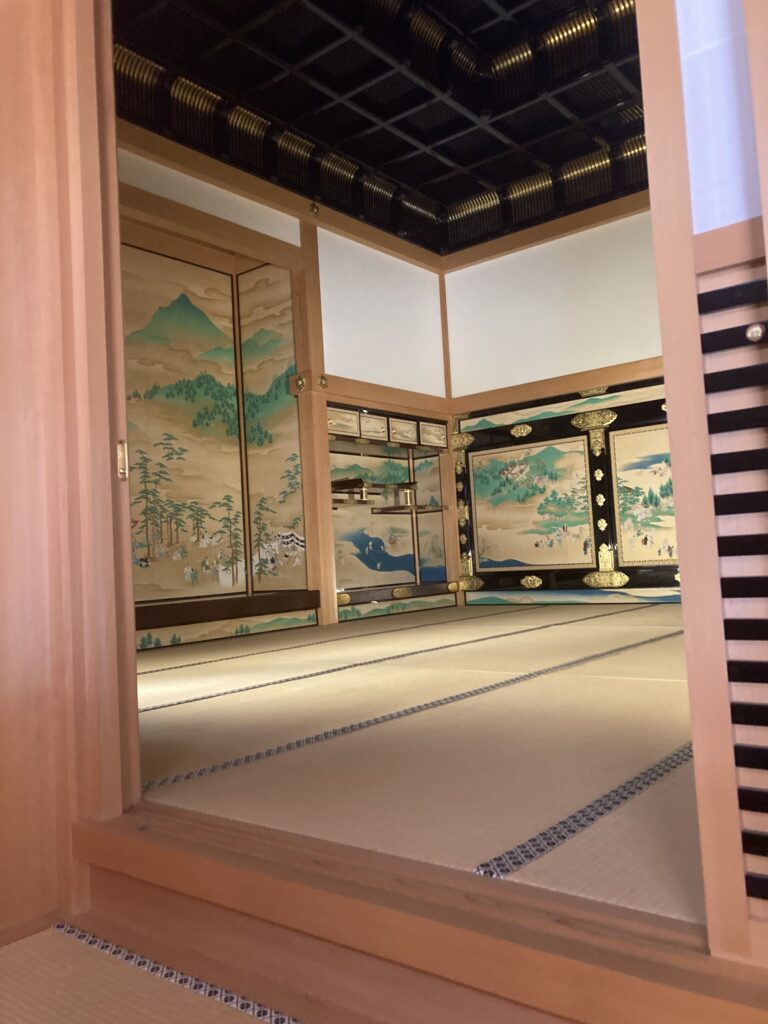
《日本語》
- 日本の城は、戦国時代の天守閣を中心とした軍事施設から、平和な時代の御殿(大規模な伝統的邸宅)を中心とした行政と生活の中心地へと変化しました。
- 御殿は、領主(大名)とその家族の主要な住居として城郭内に建てられました。その豪華で壮麗な様式は、彼らの権威と富を誇示するものでした。
- 御殿は、重要な儀式を行う場でもありました。将軍や高位の武士を迎えるために、多くの大広間が備えられていました。
- 武家住宅の最高級様式である優雅な書院造りを基本とし、御殿は、領主の好みに合わせて折り上げ格天井などの荘厳な外観を持つ要素が加えられました。
- 襖(ふすま)や壁は、将軍や領主の権力を象徴する豪華な虎や松の絵で飾られていました。これらは、来客を感動させ、威圧することも意図されていました。
- 御殿は、能舞台のような娯楽エリア、家臣を伴う役人の執務室、そして正室や側室の居住エリアを含む巨大な多機能建築物でした。
- 侍の時代が終わった後、多くの御殿は新しい政府や軍による火災や取り壊しで失われました。今日、京都や金沢など、ごく一部しかオリジナルの建物は残っていません。
- 現在、訪問者が見ることのできる御殿のほとんどは、古文書や歴史的な図面に基づいて忠実に復元されたものです。それらは、オリジナルの建物の外観と雰囲気を保っています。
- 御殿の中で、領主とその家族は、能や茶の湯、和歌を詠むなど、現代人と変わらない快適で文化的な生活を送っていました。
- 当時の将軍や領主にとって重要な役割は、できるだけ多くの子孫を残すことであり、正室のエリアは御殿の重要な部分でした。
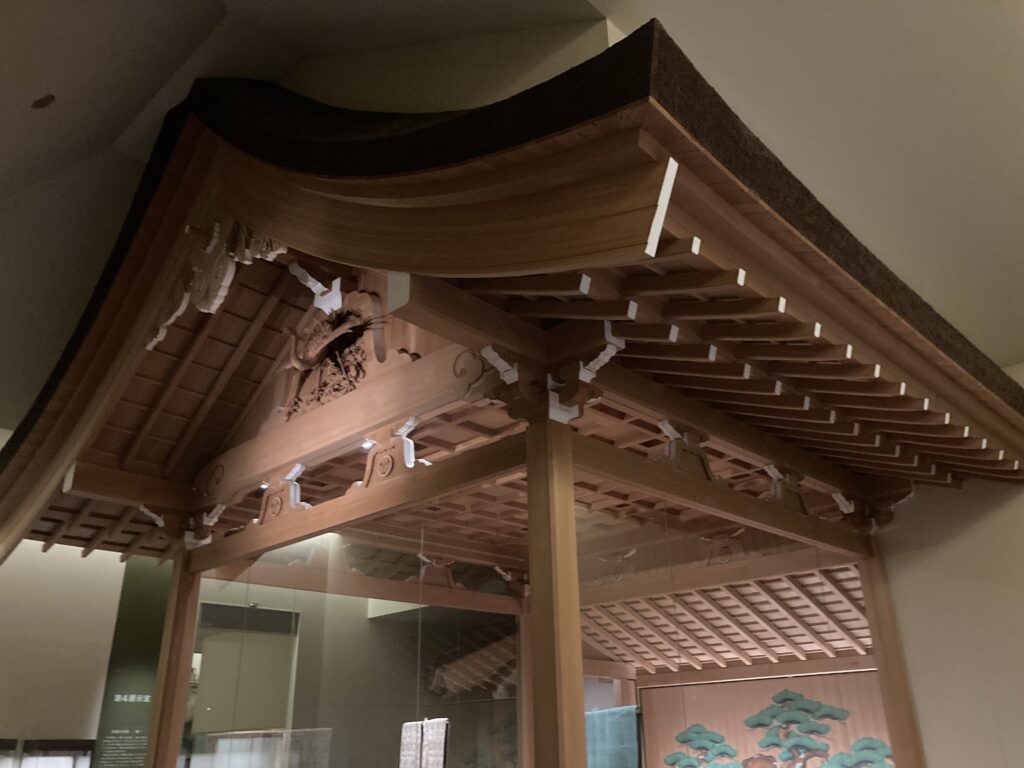
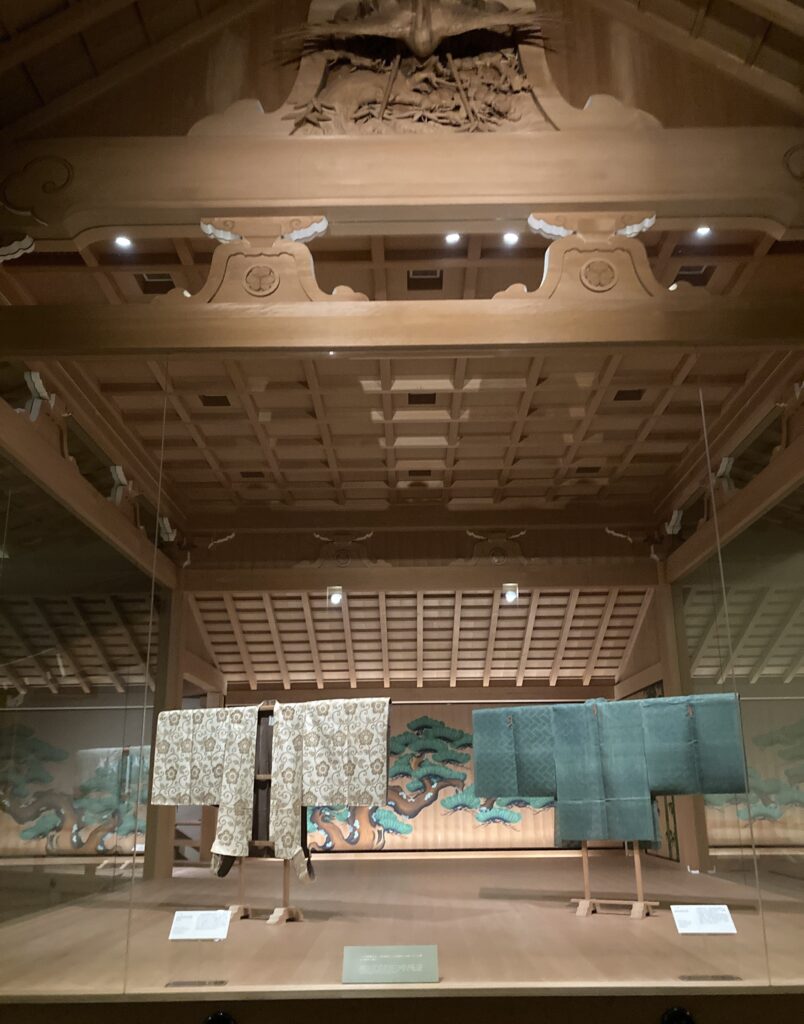
《英語》
- Japanese castles shifted from being solely military facilities centered around the tenshukaku (main tower) during the Warring States period to peaceful centers of administration and daily life focused on the goten, a large traditional mansion.
- The goten was built within the castle grounds as the main residence for the feudal lord (daimyo) and their family. Its lavish and magnificent style demonstrated their authority and wealth.
- The goten was also a crucial site for important ceremonies. It featured many large halls to welcome the shogun and other high-ranking samurai.
- As the highest form of samurai residence, the goten was based on the elegant shoin architectural style. It featured a grand appearance with elements like coffered ceilings added to suit the lord’s taste.
- The sliding doors (fusuma) and walls were decorated with opulent paintings of tigers and pine trees, symbolizing the shogun’s or lord’s power. These were often intended to impress and even intimidate guests.
- The goten was a massive, multi-functional building. It included entertaining areas like a Noh drama stage, offices for officials and vassals, and living areas for consorts and sometimes even concubines.
- After the end of the samurai era, many goten were lost due to fire or demolition by the new government and military. Today, only a few original structures remain, such as those in Kyoto and Kanazawa.
- The majority of goten visitors see today are faithful restorations based on ancient documents and historical drawings. They preserve the appearance and atmosphere of the original buildings.
- Within the goten, the lord and their family lived comfortable, cultured lives, enjoying activities like Noh drama, the tea ceremony, and composing waka poetry, much like modern people.
- A key role for shoguns and feudal lords was to produce as many heirs as possible, so the area designated for consorts was a vital part of the goten.
8.2 インバウンドの視点
御殿の内部の造りや展示物を一緒に見ながら、実際によく聞かれる質問をベースに纏めてみました。色々な回答方法がありますため、回答例として少し長めに置きましたので、お相手に合わせて一言で済ませたり一部だけ挿入したりお好みでお試しください。👇英語音声は、質問は短いので10文ともオーストラリア女性話者、回答は前半(1-5)は米国男性話者、後半(6-10)は米国女性話者の2ファイルです。
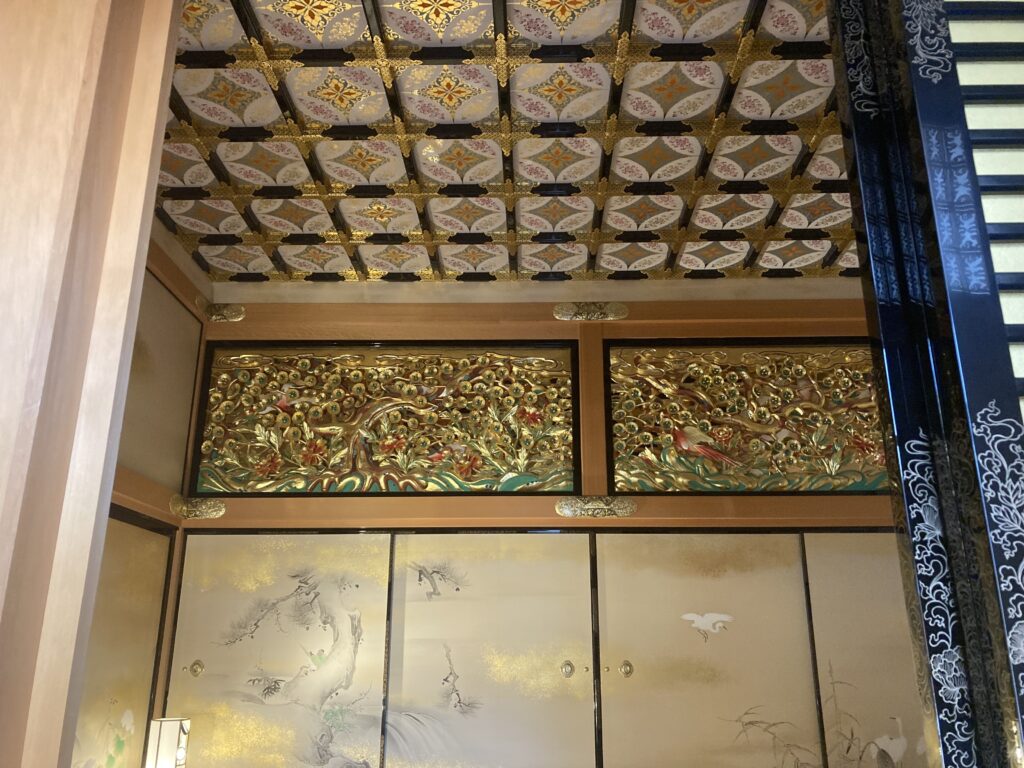
《日本語》
- Q1: 御殿は城のどこにあるのですか?
- A: 御殿は一般的に、城の最も重要な場所、つまり天守閣の近くか、城の中心にある広大な平地に建てられました。
- Q2: 天守閣と御殿は何が違うのですか?
- A: 天守閣は戦闘のために、防御や監視を目的として建てられた軍事施設です。対照的に、御殿は領主とその家族が実際に暮らすための居住空間であり、政治や儀式を行う場所でした。
- Q3: 御殿の何が面白いのですか?
- A: 御殿は、美術や建築を通して当時の領主の豪華な暮らしぶりを見ることができます。特に、金色に輝く豪華な装飾や芸術的な絵画、著名な職人による立体的な彫刻で満たされた部屋は、ほとんどの訪問者にとって非常に印象的で、時間の流れを忘れてしまうほどです。
- Q4: どの城にも御殿はあったのですか?
- A: はい、ほとんどの城には領主が住むための建物がありました。残念ながら、日本の近代化以降にそのほとんどが失われてしまいましたが、多くは歴史的記録に基づいて忠実に復元されています。
- Q5: もし完全な復元なら、火災の危険はないのですか?
- A: ご指摘の通り、過去の多くの火災は落雷や不注意が原因でした。伝統的な材料や工法で復元されていますが、現在の御殿には最新の防火システムや避雷針が組み込まれており、安全対策が施されています。
- Q6: 復元にはどのような歴史資料が使われるのですか?
- A: 復元には、主にオリジナルの設計図、絵図、部屋の装飾を描いたデザイン画などの文献資料が手がかりとなります。それに加え、発掘された建材や装飾品、工芸品の破片なども重要な証拠として活用されます。
- Q7: 御殿はなぜ低層の建物なのですか?
- A: 十分な土地があったため、わざわざ多層にする必要はありませんでした。低層にすることで、隣接する庭園との一体感を高め、どの部屋からも美しい景色を楽しめるように設計されていました。
- Q8: 御殿には部屋がいくつあったのですか?
- A: その規模は、領主の権力や財力によって大きく異なりました。将軍が所有する江戸城の御殿は100以上の部屋があったと言われています。一方、裕福な地方の領主の御殿でも、その半分以上の部屋数を持ち、非常に大規模なものでした。
- Q9: 御殿は、お城のように幕府からの厳しい建築制限はなかったのですか?
- A: いいえ、厳しい建築制限がありました。城の一部であるため、その規模や様式は、幕府からの事前の承認が必要でした。
- Q10: 御殿の復元にはどれくらいの期間と費用がかかるのですか?
- A: 期間と費用は、使用される材料や内装の豪華さによって異なりますが、5年から20年、費用は数十億円かかると言われています。これは、日本の伝統建築技術を継承しながら、当時の姿を精密に再現するためです。
《英語》
- Q1: Where in the castle is the Goten located?
- A: The goten was typically built in the most important part of the castle, near the tenshukaku (main tower) or in a vast, open area at the center of the castle grounds.
- Q2: What is the difference between the tenshukaku and the goten?
- A: The tenshukaku was a military facility built for combat, with a focus on defense and observation. In contrast, the goten was the main living space for the lord and his family, as well as the center for political and ceremonial functions.
- Q3: What’s so interesting about the goten?
- A: The goten allows you to see the luxurious lifestyle of the lords through its art and architecture. The stunning rooms, filled with golden decorations, artistic paintings, and three-dimensional carvings by prominent artisans, are so impressive that visitors can easily lose track of time.
- Q4: Do all castles have a goten?
- A: Yes, most castles had a residential building for the lord. Unfortunately, most were lost after Japan’s modernization, but many have been faithfully restored based on historical records.
- Q5: If it’s a complete restoration, is there no risk of fire?
- A: As you pointed out, many fires in the past were caused by lightning strikes or carelessness. While traditional materials and methods are used, restored goten now incorporate the latest fire prevention systems and lightning rods for safety.
- Q6: What kind of historical materials are used for restoration?
- A: For restoration, primary clues come from historical documents like original blueprints, drawings, and design sketches. Additionally, fragments of excavated building materials, ornaments, and craftwork are also used as important evidence.
- Q7: Why is the goten a low-story building?
- A: With so much available land, there was no need to build with multiple stories. The low-story design enhanced its integration with the adjacent gardens, allowing every room to have a beautiful view.
- Q8: How many rooms did the goten have?
- A: The scale varied greatly depending on the feudal lord’s power and wealth. The goten of Edo Castle, belonging to the shogun, had over 100 rooms, while wealthy provincial lords often had mansions that were more than half that size.
- Q9: Were the gotens free from the strict castle building restrictions from the shogunate?
- A: No. As part of the castle, the scale and style of the goten required prior approval from the shogunate.
- Q10: How long does it take and how much does it cost to restore a goten?
- A: The time and cost depend on the materials and the luxuriousness of the interiors, but it’s said to take 5 to 20 years and cost tens of millions of dollars. This is because the restoration aims to precisely recreate the original structure while preserving traditional Japanese building techniques.

8.3 笑いが取れるかも?説明例
一緒に御殿の中を歩きながら素朴に思うであろう想定疑問への笑いも意図した説明例です。
Q1:なぜ多くのお城の御殿は撮影禁止なのですか?
“ Why is photography prohibited in many castle’s mansions?”
頻繁に聞かれることはありませんが、場所により写真禁止ルールが微妙に異なることもあり、今回は基本原則に関する表現を織り込んでみました。👇前半(1-6)(米国男性話者)が説明にも使える真面目パート、後半(7-14)(オーストラリア女性話者)が雑談力UPを意図したおふざけパートです。
《日本語》
- 一番の理由は文化財保護のためです。
- フラッシュ撮影は、襖(ふすま)や障壁の絵画を劣化させる原因になります。
- また、訪問者が撮影に夢中になりすぎて、転倒したり、混雑を引き起こしたりするのを防ぐためでもあります。
- シャッター音は場の雰囲気を壊し、周りの人々の歴史体験を損なうことにもなりかねません。
- 復元された作品や展示物には、現代の作家の著作権が含まれているため、それを保護する必要もあります。
- これはもっともな理由で、多くの近代的な美術館と何ら変わりません。ですから、これらのルールには全く異論はありません。
- しかし、多くの御殿でゲストを案内するうちに、御殿を案内するのは美術館を案内するのとは少し違うことに気づきました。
- 万が一、外国人観光客が写真を撮ってしまった場合、その場で謝罪し、データを消去するよう求められます。
- これはガイドの説明不足も意味するため、ガイドが非難されることにもなります。
- それでも、私が感じる責任の重さは、美術館よりも御殿の方がずっと重いのです。
- 結局のところ、御殿では、主人と客との人間関係が侍の時代から全く変わっていないからです。
- かつて御殿の所有者であった将軍や藩主は、現代の政府や市町村の観光当局に代わっただけなのです。
- そして、御殿の管理スタッフは、虎の障壁画を背景に、訪問者にプレッシャーをかけ、監視する幕府や藩主の侍のようです。
- そして、私たち現地のガイドは、ゲストが失態を犯さないよう、何百年も変わらない心配と緊張を抱えながら、御殿を案内していた下級武士と同じなのですから!

《英語》
- The primary reason is the protection of cultural assets.
- Flash photography can cause the paintings on sliding doors and partitions to deteriorate.
- Photography is also prohibited to prevent visitors from becoming too absorbed in taking pictures, which can lead to falls and congestion.
- The sound of the shutter can disrupt the atmosphere of the place, detracting from the historical experience of others.
- It’s also necessary to protect the copyrights of contemporary artists whose works are included in the restored pieces and exhibits.
- That is all true, and it’s no different from many modern museums, so I have no objection to any of those rules.
- However, after guiding many guests through these mansions (goten), I’ve realized that the experience is a little different from that of a museum.
- If a visitor takes a photo, they’ll be asked to apologize and delete the data on the spot.
- This is also a failure on the part of the guide to provide a proper explanation, so the guide can be blamed.
- But the level of responsibility I feel is much heavier in a mansion than in a museum.
- After all, within the goten, the relationship between the host and the visitor hasn’t changed at all since the samurai era.
- The shogun and local lords, who were the former owners of the goten, have simply been replaced by modern government and municipal tourism authorities.
- The mansion’s management staff are like samurai from the shogunate or lords, monitoring visitors and subtly pressuring them against the backdrop of powerful tiger paintings.
- And we local guides are like the same low-ranking warriors who guided their guests through the palace, with the same worries and tensions that have remained unchanged for hundreds of years, just to make sure our guests don’t misbehave!
9. 城壁
9.1 基本情報
日本の城壁は他の目を引く構造物と比較して、存在自体が地味ですが、慣れてくると結構突っ込んでこられますのでそれを踏まえ基本点をまとめてみました。👇英語音声は英語音声は前半(1-5)米国女性話者、後半(6-10)米国男性話者の2ファイルです。
《日本語》
- 日本の城壁は、単なる防御施設ではなく、敵の侵入を防ぐための重要な要塞だった。通常の壁にはない、様々な独自の工夫が凝らされていた。
- 城壁の強みは、その構造だけでなく、配置にもあった。複数の櫓(やぐら)を繋ぐ多聞櫓(たもんやぐら)という横長の建物も、重要な城壁の一部だった。
- 城壁は美観も重視された。漆喰壁の白と瓦の黒のコントラスト、複雑な石垣と組み合わせた曲線など、日本の美意識が随所に反映されていた。
- 城壁は防御のために設計されていたが、狭間(さま)と呼ばれる無数の小さな穴を通じて反撃も可能だった。これらの多くは外部の壁で覆われており、外からは見えないようになっていた。
- 狭間は、外側から狙われにくいように狭く、内側からは広い視野が確保できるよう漏斗(ろうと)のような形をしていた。
- さらなる防御力向上のため、石落とし(いしおとし)という張り出しが設けられた。これは、城壁の下にいる敵に石や熱湯を落とすための仕掛だった。
- この仕掛けは、単純な構造にもかかわらず、非常に効果的で費用対効果が高かった。物を落とすだけで、ほとんどメンテナンスが不要だったため、ほとんどの城で一般的な特徴となった。
- 漆喰(しっくい)は、防火・防水効果が高かっただけでなく、城を白く美しく見せることで、その権威を高める役割も果たした。
- 瓦を並べ、その継ぎ目をナマコのように漆喰で盛り上げた海鼠壁(なまこかべ)は、装飾性が高く、城だけでなく商家や土蔵にも広く使われた。
- 近代の鉄筋コンクリートが強度を追求して生まれたのに対し、日本の城壁は、木や竹の骨組みに地元の土や漆喰を塗り重ねて作られた。これは、地元で調達できる材料と、日本の多湿な気候に適応した結果だった。
《英語》
- Japanese castle walls were a critical part of the defensive fortifications, featuring unique innovations not found in ordinary walls.
- The strength of the walls wasn’t just in their construction; their placement was also strategic. A great example is the tamon-yagura, a long turret that connects multiple sections of the wall.
- The walls also emphasized aesthetics, with the contrast of the white plaster and black tiles and the flowing curves of the stone foundations reflecting the Japanese sense of beauty.
- While the walls were designed for defense, they also allowed for counterattacks through numerous small holes called sama. Many of these were hidden or covered, making them invisible from the outside.
- The sama holes were designed to be narrow on the outside, making them difficult for attackers to target, while a funnel-like shape on the inside provided a wider field of vision for defenders.
- To further boost defense, ishi otoshi (stone drop-offs) were added. These overhangs allowed defenders to drop stones or boiling water on enemies directly below the walls.
- Despite its simple mechanism, this feature was highly effective and cost-efficient. It required almost no maintenance—defenders simply needed to drop objects—making it a common addition to most castles.
- Plaster was widely used for its fire and water-resistant properties, as well as for its aesthetic appeal, making the castles appear pristine and a symbol of power.
- Namako walls, a decorative style where raised plaster joints resemble a sea cucumber, were popular in castles but were also widely used on merchant houses and storehouses because of their high decorative value and durability.
- Unlike reinforced concrete, a modern material born from the need for strength, a castle wall’s construction—layered with local soil and plaster over a wood and bamboo frame—was a response to the availability of local resources and Japan’s humid climate.
9.2 インバウンドの視点
城内を歩きながら、又、城の内部で壁に関する展示物を一緒に見ながら、実際によく聞かれる質問をベースに纏めてみました。お相手の知識や関心度に合わせた対応ができますよう、回答例は少し長めに雑談ネタも適当にはさみました。👇英語音声は、質問は短いので10文ともインド女性話者、回答は前半(1-5)はオーストラリア男性話者、後半(6-10)は英国女性話者の2ファイルです。
《日本語》
- そもそも城の壁は何でできているのですか?
- 回答: 日本の城壁は、主に土、木、漆喰(しっくい)といった自然素材でできています。石垣の上に、木や竹の骨組みを組んで土を固めた壁を立て、その表面を漆喰で仕上げるのが一般的な構造です。
- なぜ城の壁は白いのですか?
- 回答: 白い壁は漆喰(しっくい)で塗られているからです。漆喰は火に強く、水を弾く効果があり、城を火災や湿気から守る役割を果たしました。また、その白く輝く外観は、城主の権威と力を象徴するものでもありました。
- なぜ白と黒の網目デザインの壁があるのですか?
- 回答: 美しい模様に見えますが、これはとても機能的なデザインです。黒い瓦と白い漆喰を組み合わせることで、壁の防火・防水性を高める工夫がなされています。
- その白黒デザインは何で出来ているのですか?
- 回答: 黒い部分は瓦で、盛り上がった白い部分は**漆喰(しっくい)**です。盛り上がった漆喰が海の生物であるナマコに似ていることから、海鼠壁と呼ばれています。
- 壁の素材はどこから調達していたのですか?
- 回答: 主に地元の素材が使われました。しかし、良質な土や特定の材料が近くで手に入らない場合は、遠くの山から運び込まれることもありました。
- (展示物を見て)なぜ壁の断面は何層もあるのですか?
- 回答: この多層構造は巧妙な防御戦略でした。内部に木や竹の骨組みを組み、その上から何層にも土や漆喰を塗り重ねることで、壁の強度と耐久性を高めています。中には、鉄砲の弾丸を通さないように小石の層を挟んでいるものもありました。
- なぜ日本の城の壁は耐火性のある石製ではないのですか?
- 回答: 頑丈で重い石の壁は、地震の多い日本には適していませんでした。地震の揺れで崩れやすかったからです。木と土を使った柔軟な構造と、ある程度の耐火性がある漆喰を組み合わせる方が、より効果的な解決策でした。
- 城の壁は通常の日本家屋の壁と同じですか?
- 回答: 見た目は似ていますが、構造は全く違います。城壁は防御のために、より厚く、複数の素材の層を重ねて頑丈に作られています。
- 城の壁は当時のままのものですか?
- 回答: 国宝級の城であっても、壁は当時のままではありません。風雨にさらされるため、数十年ごとに定期的なメンテナンスが必要だからです。現在見られる城の壁は、何世代にもわたる継続的な修復の結果なのです。
- 城の壁に耐震性はあるのですか?
- 回答: はい、あります。日本の城壁は、異なる素材を組み合わせた柔軟な多層構造によって、地震の揺れを吸収・分散することができます。これは、石造りの城が一般的な西洋では見られない、地震国である日本で独自に発展した特徴です。
《英語》
- What are the walls of the castle made of?
- Answer: The walls of Japanese castles were mainly built from natural materials like earth, wood, and plaster. They were generally constructed on top of stone foundations, using a framework of wood or bamboo, which was then layered with hardened earth and finished with a coat of plaster.
- Why are the walls of the castle white?
- Answer: The white walls are coated in plaster, which served a dual purpose. It protected the castle from fire and moisture, and its brilliant white color symbolized the owner’s power and authority.
- Why is there a black and white mesh design on the walls?
- Answer: While it looks like a beautiful pattern, it’s a highly functional design. This was created by combining black tiles and white plaster to increase the walls’ resistance to fire and water.
- What is the black and white design made of?
- Answer: The black parts are tiles, and the raised white areas are plaster. This style is called the namako wall because the raised plaster joints resemble a sea cucumber.
- Where were the wall materials sourced?
- Answer: Materials were primarily sourced locally. However, if high-quality soil or other specific materials were not available nearby, they were transported from distant mountains to ensure the wall’s durability and quality.
- (Looking at the exhibits) Why are there many layers in the cross section of the walls?
- Answer: The multi-layered structure was a clever defensive strategy. A framework of wood or bamboo was built inside, then covered with multiple layers of earth and plaster to increase the wall’s strength and durability. Some walls were even filled with layers of pebbles to stop bullets.
- Why aren’t the walls of Japanese castles made of fire-resistant stone?
- Answer: Sturdy but heavy stone walls were not suitable for earthquake-prone Japan because they were prone to collapse. The flexible, multi-layered design of Japanese castle walls, which used materials like plaster with some fire resistance, was a more effective solution.
- Are the walls of a castle the same as those of a regular Japanese house?
- Answer: They might look similar, but their construction is completely different. Castle walls were built for defense, so they are thicker and much stronger, with multiple layers of different materials to withstand attacks.
- Are the walls of a castle still the same as they were in those days?
- Answer: Even the walls of national treasure castles are not exactly as they were in the past. They require regular maintenance every few decades to prevent decay. Therefore, the walls you see today, whether in original or restored castles, are the result of continuous upkeep over many generations.
- Are castle walls earthquake resistant?
- Answer: Yes, they are. Japanese castle walls have a flexible, multi-layered structure combining different materials, which allows them to absorb and disperse seismic energy. This unique feature developed in Japan as a way to cope with frequent earthquakes, and it’s not typically seen in the stone castles of the West.
9.3 笑いが取れるかも?説明例
一緒に城内を歩きながら素朴に思うであろう想定疑問への笑いも意図した説明例です。今回はナマコの時事ネタを織り込んでみました。👇前半(1-7)(米国男性話者)が説明にも使える真面目パート、後半(8-16)(オーストラリア女性話者)が雑談力UPを意図したおふざけパートです。
Q1:ナマコ壁は食べられますか?
“Can this sea cucumber wall be eaten?”
日本人には信じられないかもしれませんが、実際に(特にナマコの美味しさを説明をしていると)時々聞かれる質問を元に纏めてみました。
《日本語》
- 残念ながら、この壁は食べられません。
- 先ほどご説明した通り、この壁の呼び名はその外見から来ています。
- この工法では、壁に平瓦を並べて貼り、その隙間を半円形に盛り上げた漆喰で埋めます。
- この盛り上がった漆喰が、海にいる軟体動物のナマコに似ているため、この壁は通称「ナマコ壁」と呼ばれるようになったのです。
- 日本では、古くからナマコは珍味として食され、コリコリした独特の食感で今でも人気があります。
- また、中国では滋養強壮に良い漢方薬や高級食材として重宝されてきました。
- 近年では健康志向の高まりから、粉末状に加工されたナマコがオンラインで人気となり、日本からの輸出も増えています。
- このことを考えると、私たち地元のガイドも、近いうちに外国人観光客をご案内する際に注意が必要かもしれません。
- あの不気味な色と、芋虫のような形から、ナマコを食べず嫌いな人はたくさんいます。
- 私自身も、初めてナマコを食べた人は相当お腹が空いていたのだろうと思います。
- しかし、健康のために粉末状のナマコを食べる人が増えると、本物のナマコを見たことがない多くの人が、粉末が本物のナマコだと勘違いするかもしれません。
- もしそんな人が、日本の城にある「ナマコ壁」を見て、粉末のナマコでできていると勘違いする可能性もゼロではありません。
- 昔、シャワー後の猫を電子レンジで乾かそうとして、猫を死なせてしまった悲しい事件をご存知ですか?
- その事件以来、電子レンジの製造元は「電子レンジで猫を乾かさないでください」という注意書きの表示を義務付けられました。
- もしかしたら、いつかこのナマコ壁にも注意書きが必要になるかもしれませんね。
- 「このナマコ壁は食べられません」って!
《英語》
- Unfortunately, this wall is not edible.
- As I explained earlier, the name comes entirely from its appearance.
- In this building method, flat tiles are laid side by side on the wall, and the gaps between them are filled with plaster in a raised, semicircular shape.
- The raised plaster resembles a sea cucumber, a mollusk that lives in the ocean, which is why the wall is commonly called “sea cucumber wall.”
- In Japan, sea cucumbers have been consumed as a delicacy since ancient times and are still popular today for their unique crunchy texture.
- In China, they have long been prized as a tonic and a luxury food for their purported health benefits.
- Because of this, powdered sea cucumber has become a popular health food sold online in recent years, and exports from Japan are on the rise.
- This means we local tour guides might have to be more careful when guiding foreign guests in the near future.
- Many people dislike eating sea cucumbers due to their grotesque, caterpillar-like shape and eerie color.
- I personally believe the first person to eat one must have been incredibly hungry!
- But as more people consume powdered sea cucumber for health reasons, many who have never seen a real one might mistake the powder for the actual thing.
- If these people see a white wall called a “sea cucumber wall” in a Japanese castle, they might mistakenly think it’s made of powdered sea cucumber.
- Do you remember that old, tragic story about the cat that was killed after its owner tried to dry it in a microwave?
- Since then, microwave manufacturers have been required to put a label on their products saying, “Do not dry cats in a microwave oven.”
- Maybe someday, our sea cucumber walls will be required to have a similar label that says:
- “This sea cucumber wall is not edible.
ご参考🔶『腑に落ちる』10例
- It finally makes sense!/I see the point now!
- I understand now! / I am convinced now!
- I am satisfied! /I feel content now!
- I am impressed! /I am amazed!
- It hit me!/ It dawned on me!
御礼🔶後書き
🔶今回も最後まで読んで頂き大変ありがとうございます。もし何かご意見やリクエストございましたらお気軽に『Help Desk』にてお声がけくださいませ。Gold🔶R50207.V.10b.10b.5a/
